Human Resource Development: A Comprehensive Guide to Training and Development
VerifiedAdded on 2024/05/30
|27
|5376
|144
AI Summary
This comprehensive guide explores the fundamentals of human resource development, encompassing learning styles, training needs assessment, and the role of government in shaping training initiatives. It delves into the importance of learning transfer within the workplace and examines the effectiveness of various training methods. The guide also analyzes the impact of competency movements on public and private sector organizations, using Chanel as a case study to illustrate the practical application of these concepts.
Contribute Materials
Your contribution can guide someone’s learning journey. Share your
documents today.
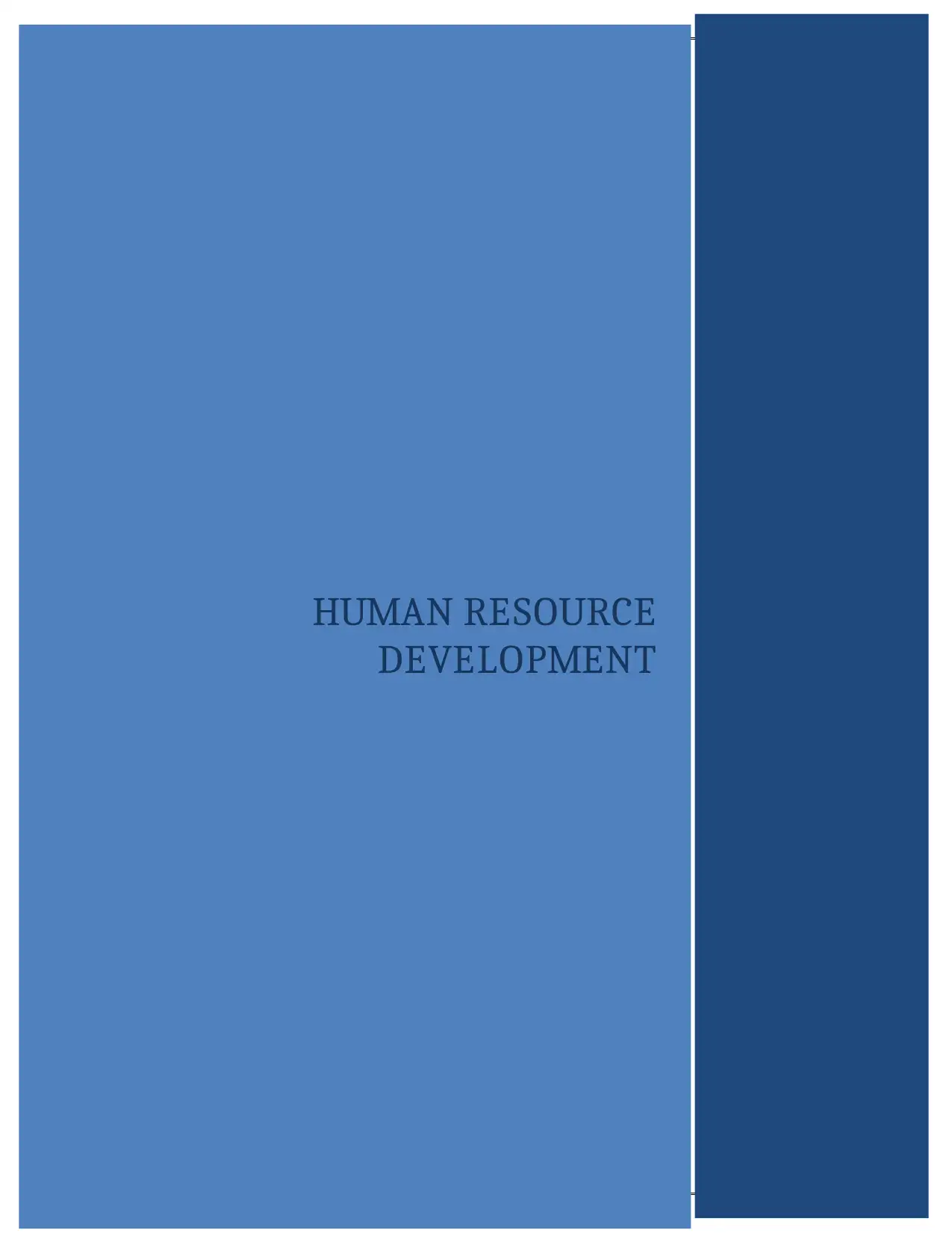
HUMAN RESOURCE
DEVELOPMENT
DEVELOPMENT
Secure Best Marks with AI Grader
Need help grading? Try our AI Grader for instant feedback on your assignments.
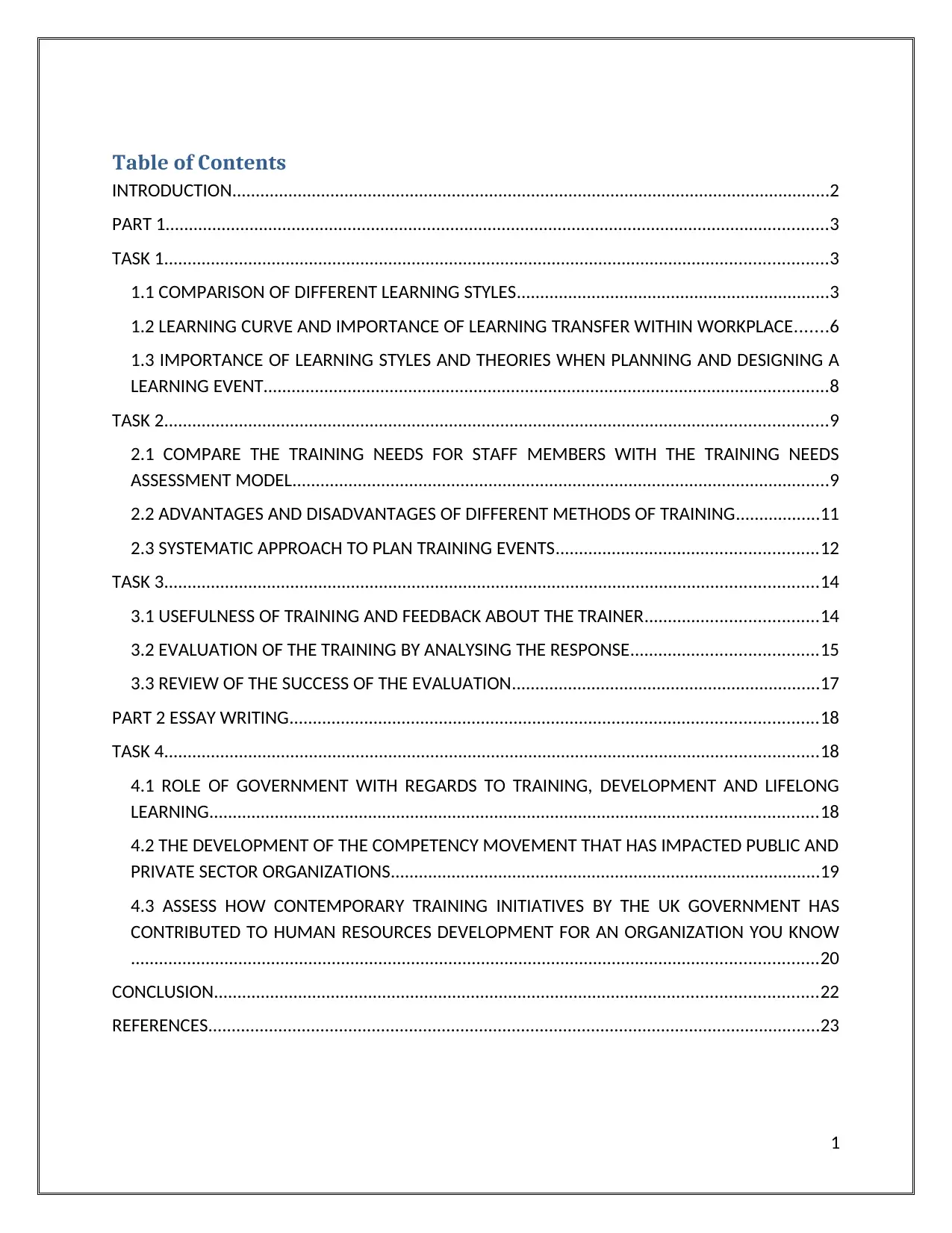
Table of Contents
INTRODUCTION................................................................................................................................2
PART 1..............................................................................................................................................3
TASK 1..............................................................................................................................................3
1.1 COMPARISON OF DIFFERENT LEARNING STYLES...................................................................3
1.2 LEARNING CURVE AND IMPORTANCE OF LEARNING TRANSFER WITHIN WORKPLACE.......6
1.3 IMPORTANCE OF LEARNING STYLES AND THEORIES WHEN PLANNING AND DESIGNING A
LEARNING EVENT.........................................................................................................................8
TASK 2..............................................................................................................................................9
2.1 COMPARE THE TRAINING NEEDS FOR STAFF MEMBERS WITH THE TRAINING NEEDS
ASSESSMENT MODEL...................................................................................................................9
2.2 ADVANTAGES AND DISADVANTAGES OF DIFFERENT METHODS OF TRAINING..................11
2.3 SYSTEMATIC APPROACH TO PLAN TRAINING EVENTS........................................................12
TASK 3............................................................................................................................................14
3.1 USEFULNESS OF TRAINING AND FEEDBACK ABOUT THE TRAINER.....................................14
3.2 EVALUATION OF THE TRAINING BY ANALYSING THE RESPONSE........................................15
3.3 REVIEW OF THE SUCCESS OF THE EVALUATION..................................................................17
PART 2 ESSAY WRITING.................................................................................................................18
TASK 4............................................................................................................................................18
4.1 ROLE OF GOVERNMENT WITH REGARDS TO TRAINING, DEVELOPMENT AND LIFELONG
LEARNING..................................................................................................................................18
4.2 THE DEVELOPMENT OF THE COMPETENCY MOVEMENT THAT HAS IMPACTED PUBLIC AND
PRIVATE SECTOR ORGANIZATIONS............................................................................................19
4.3 ASSESS HOW CONTEMPORARY TRAINING INITIATIVES BY THE UK GOVERNMENT HAS
CONTRIBUTED TO HUMAN RESOURCES DEVELOPMENT FOR AN ORGANIZATION YOU KNOW
...................................................................................................................................................20
CONCLUSION.................................................................................................................................22
REFERENCES...................................................................................................................................23
1
INTRODUCTION................................................................................................................................2
PART 1..............................................................................................................................................3
TASK 1..............................................................................................................................................3
1.1 COMPARISON OF DIFFERENT LEARNING STYLES...................................................................3
1.2 LEARNING CURVE AND IMPORTANCE OF LEARNING TRANSFER WITHIN WORKPLACE.......6
1.3 IMPORTANCE OF LEARNING STYLES AND THEORIES WHEN PLANNING AND DESIGNING A
LEARNING EVENT.........................................................................................................................8
TASK 2..............................................................................................................................................9
2.1 COMPARE THE TRAINING NEEDS FOR STAFF MEMBERS WITH THE TRAINING NEEDS
ASSESSMENT MODEL...................................................................................................................9
2.2 ADVANTAGES AND DISADVANTAGES OF DIFFERENT METHODS OF TRAINING..................11
2.3 SYSTEMATIC APPROACH TO PLAN TRAINING EVENTS........................................................12
TASK 3............................................................................................................................................14
3.1 USEFULNESS OF TRAINING AND FEEDBACK ABOUT THE TRAINER.....................................14
3.2 EVALUATION OF THE TRAINING BY ANALYSING THE RESPONSE........................................15
3.3 REVIEW OF THE SUCCESS OF THE EVALUATION..................................................................17
PART 2 ESSAY WRITING.................................................................................................................18
TASK 4............................................................................................................................................18
4.1 ROLE OF GOVERNMENT WITH REGARDS TO TRAINING, DEVELOPMENT AND LIFELONG
LEARNING..................................................................................................................................18
4.2 THE DEVELOPMENT OF THE COMPETENCY MOVEMENT THAT HAS IMPACTED PUBLIC AND
PRIVATE SECTOR ORGANIZATIONS............................................................................................19
4.3 ASSESS HOW CONTEMPORARY TRAINING INITIATIVES BY THE UK GOVERNMENT HAS
CONTRIBUTED TO HUMAN RESOURCES DEVELOPMENT FOR AN ORGANIZATION YOU KNOW
...................................................................................................................................................20
CONCLUSION.................................................................................................................................22
REFERENCES...................................................................................................................................23
1
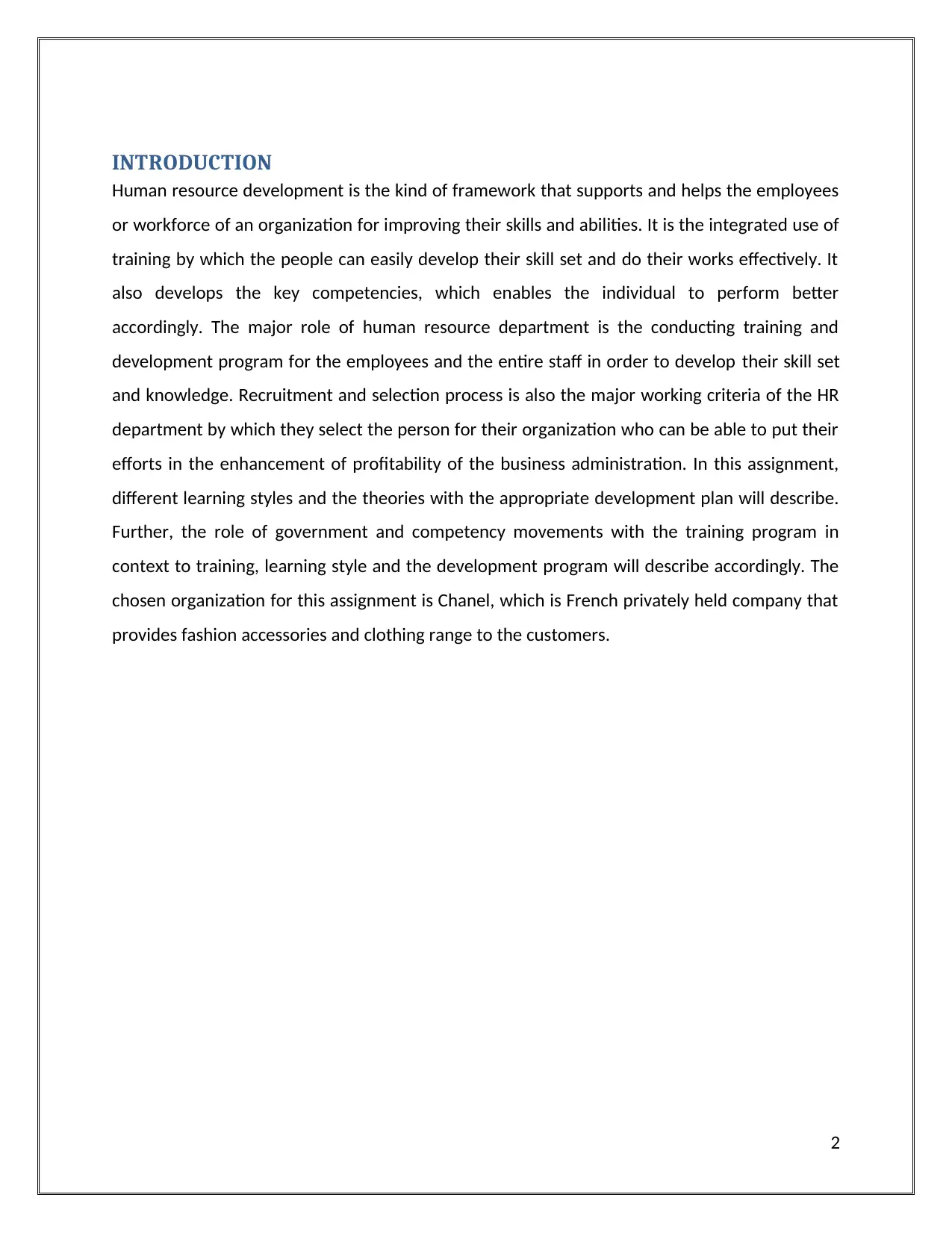
INTRODUCTION
Human resource development is the kind of framework that supports and helps the employees
or workforce of an organization for improving their skills and abilities. It is the integrated use of
training by which the people can easily develop their skill set and do their works effectively. It
also develops the key competencies, which enables the individual to perform better
accordingly. The major role of human resource department is the conducting training and
development program for the employees and the entire staff in order to develop their skill set
and knowledge. Recruitment and selection process is also the major working criteria of the HR
department by which they select the person for their organization who can be able to put their
efforts in the enhancement of profitability of the business administration. In this assignment,
different learning styles and the theories with the appropriate development plan will describe.
Further, the role of government and competency movements with the training program in
context to training, learning style and the development program will describe accordingly. The
chosen organization for this assignment is Chanel, which is French privately held company that
provides fashion accessories and clothing range to the customers.
2
Human resource development is the kind of framework that supports and helps the employees
or workforce of an organization for improving their skills and abilities. It is the integrated use of
training by which the people can easily develop their skill set and do their works effectively. It
also develops the key competencies, which enables the individual to perform better
accordingly. The major role of human resource department is the conducting training and
development program for the employees and the entire staff in order to develop their skill set
and knowledge. Recruitment and selection process is also the major working criteria of the HR
department by which they select the person for their organization who can be able to put their
efforts in the enhancement of profitability of the business administration. In this assignment,
different learning styles and the theories with the appropriate development plan will describe.
Further, the role of government and competency movements with the training program in
context to training, learning style and the development program will describe accordingly. The
chosen organization for this assignment is Chanel, which is French privately held company that
provides fashion accessories and clothing range to the customers.
2
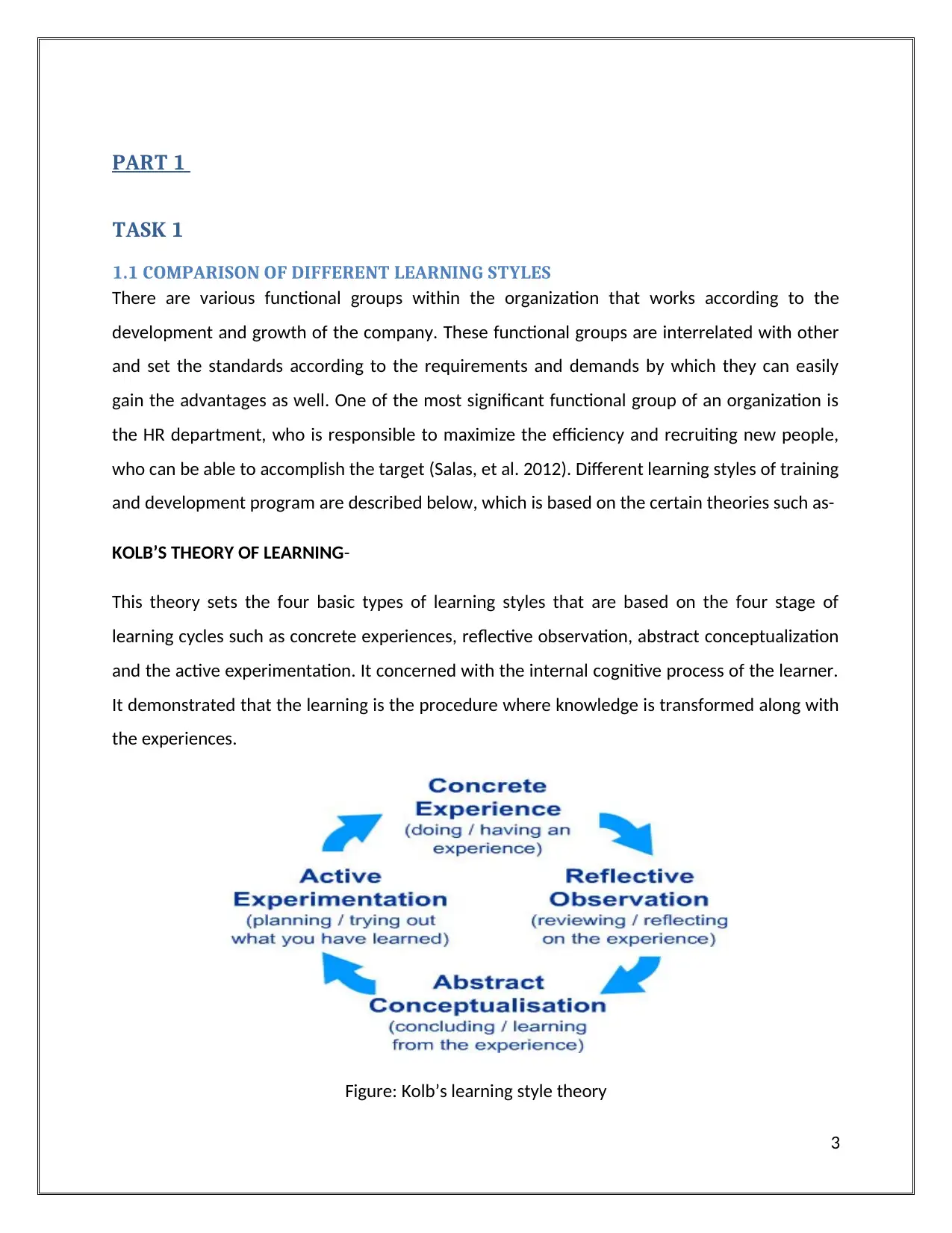
PART 1
TASK 1
1.1 COMPARISON OF DIFFERENT LEARNING STYLES
There are various functional groups within the organization that works according to the
development and growth of the company. These functional groups are interrelated with other
and set the standards according to the requirements and demands by which they can easily
gain the advantages as well. One of the most significant functional group of an organization is
the HR department, who is responsible to maximize the efficiency and recruiting new people,
who can be able to accomplish the target (Salas, et al. 2012). Different learning styles of training
and development program are described below, which is based on the certain theories such as-
KOLB’S THEORY OF LEARNING-
This theory sets the four basic types of learning styles that are based on the four stage of
learning cycles such as concrete experiences, reflective observation, abstract conceptualization
and the active experimentation. It concerned with the internal cognitive process of the learner.
It demonstrated that the learning is the procedure where knowledge is transformed along with
the experiences.
Figure: Kolb’s learning style theory
3
TASK 1
1.1 COMPARISON OF DIFFERENT LEARNING STYLES
There are various functional groups within the organization that works according to the
development and growth of the company. These functional groups are interrelated with other
and set the standards according to the requirements and demands by which they can easily
gain the advantages as well. One of the most significant functional group of an organization is
the HR department, who is responsible to maximize the efficiency and recruiting new people,
who can be able to accomplish the target (Salas, et al. 2012). Different learning styles of training
and development program are described below, which is based on the certain theories such as-
KOLB’S THEORY OF LEARNING-
This theory sets the four basic types of learning styles that are based on the four stage of
learning cycles such as concrete experiences, reflective observation, abstract conceptualization
and the active experimentation. It concerned with the internal cognitive process of the learner.
It demonstrated that the learning is the procedure where knowledge is transformed along with
the experiences.
Figure: Kolb’s learning style theory
3
Secure Best Marks with AI Grader
Need help grading? Try our AI Grader for instant feedback on your assignments.
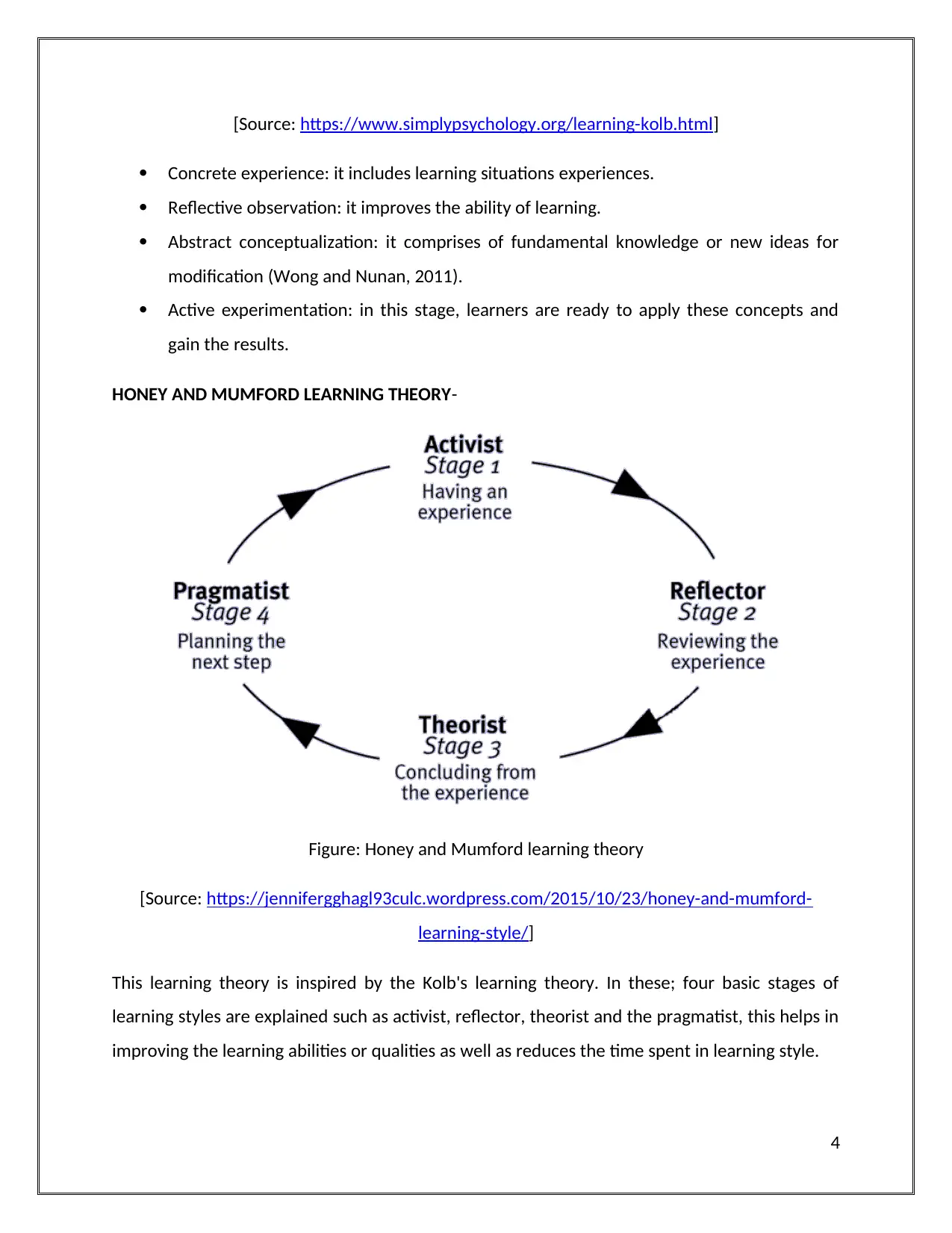
[Source: https://www.simplypsychology.org/learning-kolb.html]
Concrete experience: it includes learning situations experiences.
Reflective observation: it improves the ability of learning.
Abstract conceptualization: it comprises of fundamental knowledge or new ideas for
modification (Wong and Nunan, 2011).
Active experimentation: in this stage, learners are ready to apply these concepts and
gain the results.
HONEY AND MUMFORD LEARNING THEORY-
Figure: Honey and Mumford learning theory
[Source: https://jennifergghagl93culc.wordpress.com/2015/10/23/honey-and-mumford-
learning-style/]
This learning theory is inspired by the Kolb's learning theory. In these; four basic stages of
learning styles are explained such as activist, reflector, theorist and the pragmatist, this helps in
improving the learning abilities or qualities as well as reduces the time spent in learning style.
4
Concrete experience: it includes learning situations experiences.
Reflective observation: it improves the ability of learning.
Abstract conceptualization: it comprises of fundamental knowledge or new ideas for
modification (Wong and Nunan, 2011).
Active experimentation: in this stage, learners are ready to apply these concepts and
gain the results.
HONEY AND MUMFORD LEARNING THEORY-
Figure: Honey and Mumford learning theory
[Source: https://jennifergghagl93culc.wordpress.com/2015/10/23/honey-and-mumford-
learning-style/]
This learning theory is inspired by the Kolb's learning theory. In these; four basic stages of
learning styles are explained such as activist, reflector, theorist and the pragmatist, this helps in
improving the learning abilities or qualities as well as reduces the time spent in learning style.
4
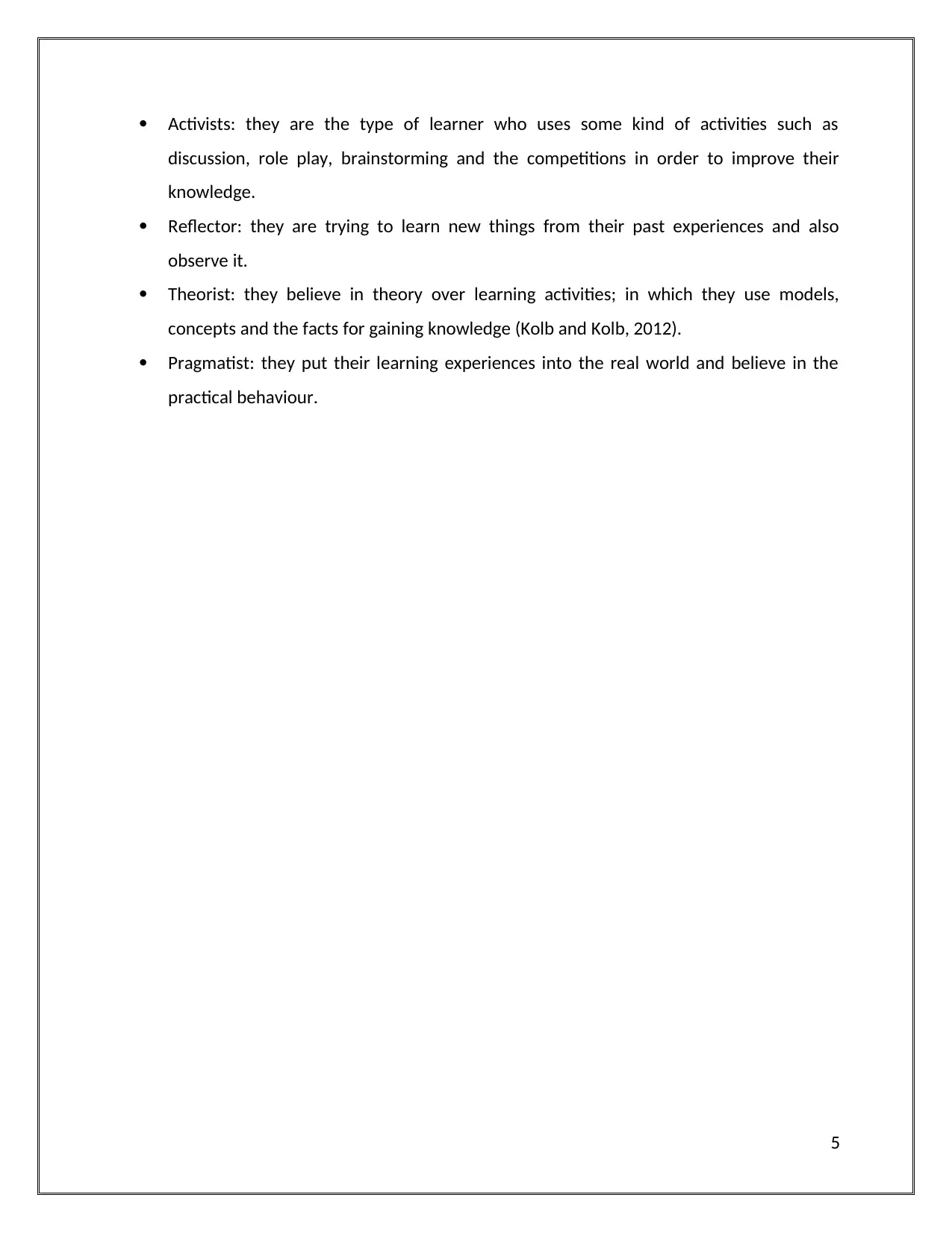
Activists: they are the type of learner who uses some kind of activities such as
discussion, role play, brainstorming and the competitions in order to improve their
knowledge.
Reflector: they are trying to learn new things from their past experiences and also
observe it.
Theorist: they believe in theory over learning activities; in which they use models,
concepts and the facts for gaining knowledge (Kolb and Kolb, 2012).
Pragmatist: they put their learning experiences into the real world and believe in the
practical behaviour.
5
discussion, role play, brainstorming and the competitions in order to improve their
knowledge.
Reflector: they are trying to learn new things from their past experiences and also
observe it.
Theorist: they believe in theory over learning activities; in which they use models,
concepts and the facts for gaining knowledge (Kolb and Kolb, 2012).
Pragmatist: they put their learning experiences into the real world and believe in the
practical behaviour.
5
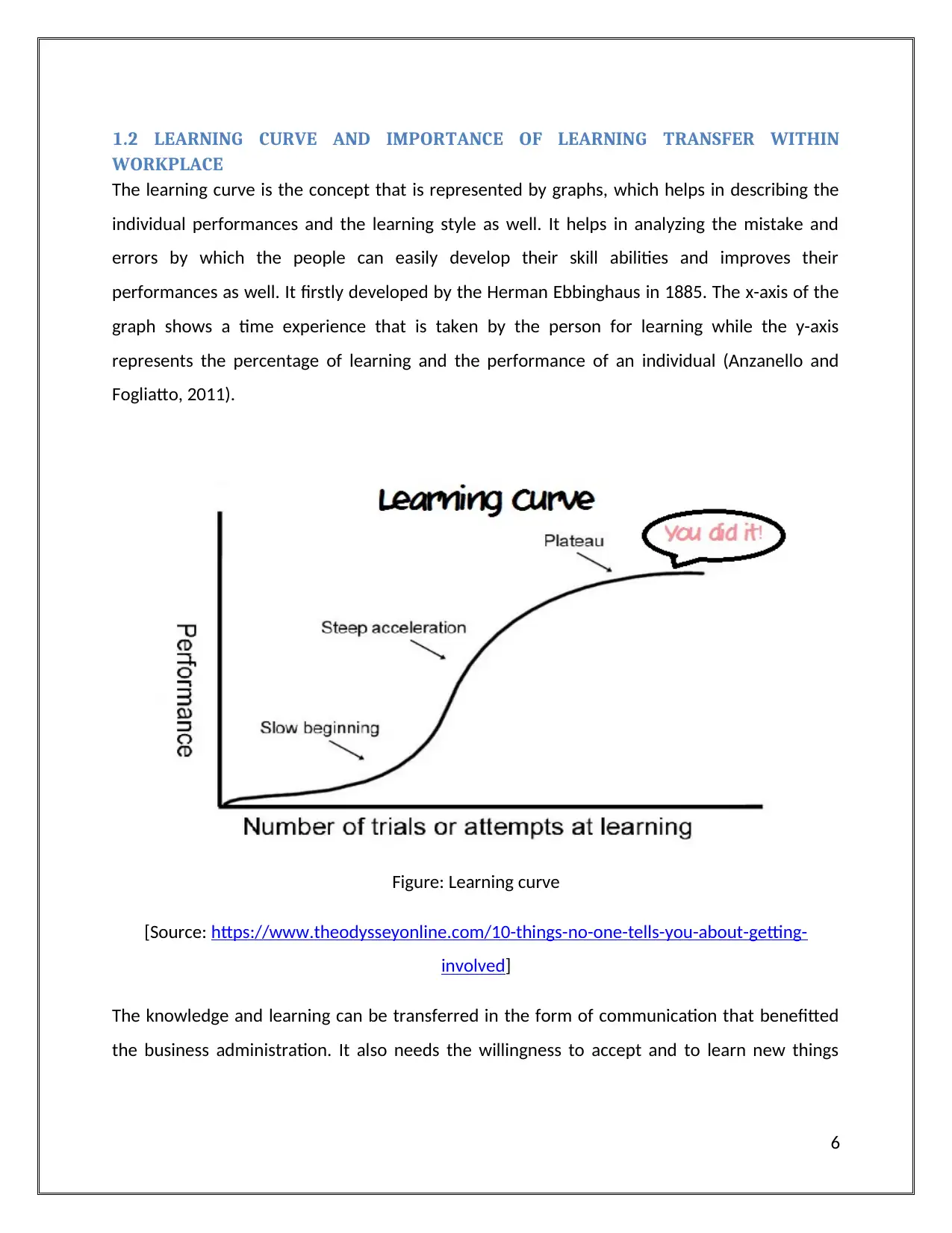
1.2 LEARNING CURVE AND IMPORTANCE OF LEARNING TRANSFER WITHIN
WORKPLACE
The learning curve is the concept that is represented by graphs, which helps in describing the
individual performances and the learning style as well. It helps in analyzing the mistake and
errors by which the people can easily develop their skill abilities and improves their
performances as well. It firstly developed by the Herman Ebbinghaus in 1885. The x-axis of the
graph shows a time experience that is taken by the person for learning while the y-axis
represents the percentage of learning and the performance of an individual (Anzanello and
Fogliatto, 2011).
Figure: Learning curve
[Source: https://www.theodysseyonline.com/10-things-no-one-tells-you-about-getting-
involved]
The knowledge and learning can be transferred in the form of communication that benefitted
the business administration. It also needs the willingness to accept and to learn new things
6
WORKPLACE
The learning curve is the concept that is represented by graphs, which helps in describing the
individual performances and the learning style as well. It helps in analyzing the mistake and
errors by which the people can easily develop their skill abilities and improves their
performances as well. It firstly developed by the Herman Ebbinghaus in 1885. The x-axis of the
graph shows a time experience that is taken by the person for learning while the y-axis
represents the percentage of learning and the performance of an individual (Anzanello and
Fogliatto, 2011).
Figure: Learning curve
[Source: https://www.theodysseyonline.com/10-things-no-one-tells-you-about-getting-
involved]
The knowledge and learning can be transferred in the form of communication that benefitted
the business administration. It also needs the willingness to accept and to learn new things
6
Paraphrase This Document
Need a fresh take? Get an instant paraphrase of this document with our AI Paraphraser
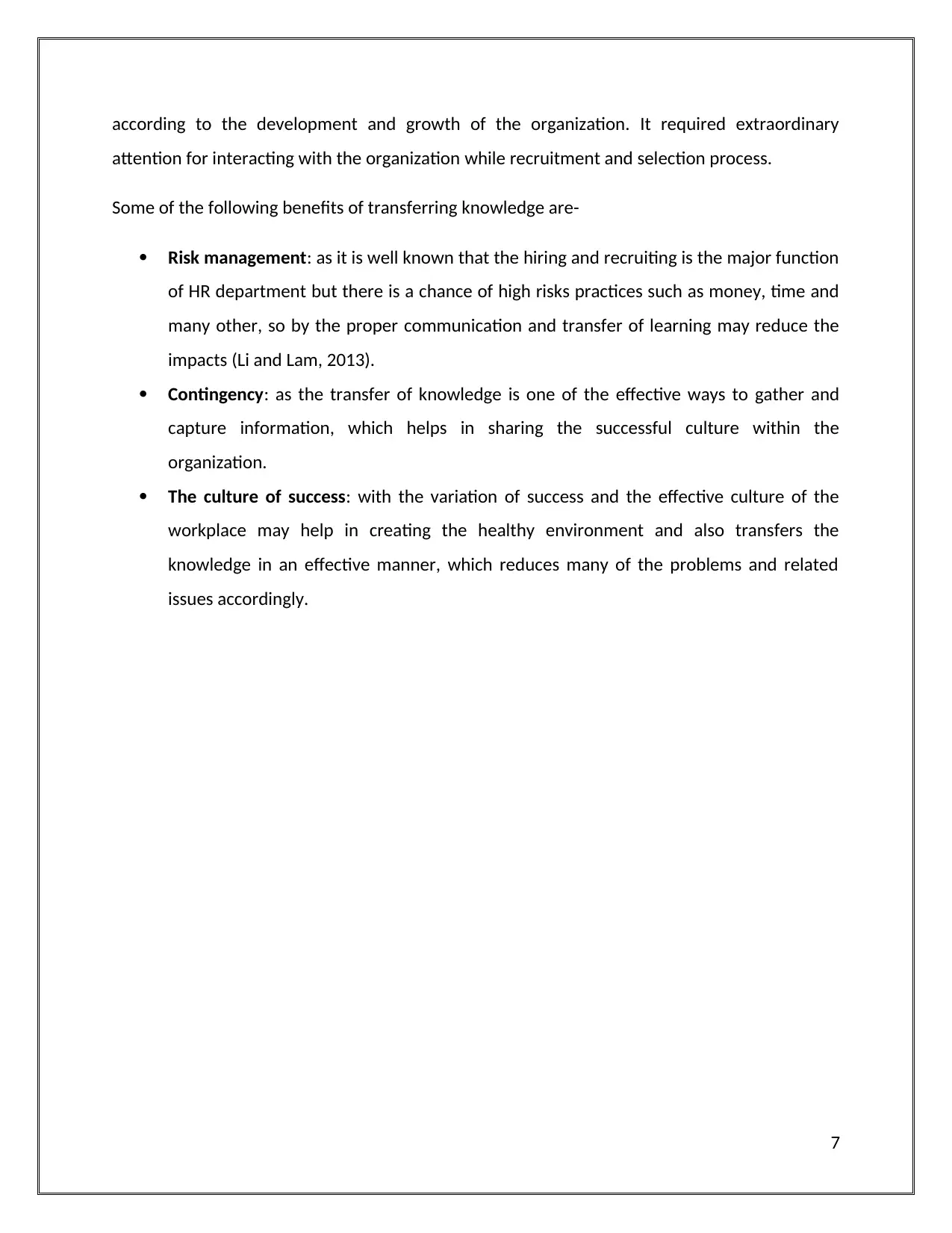
according to the development and growth of the organization. It required extraordinary
attention for interacting with the organization while recruitment and selection process.
Some of the following benefits of transferring knowledge are-
Risk management: as it is well known that the hiring and recruiting is the major function
of HR department but there is a chance of high risks practices such as money, time and
many other, so by the proper communication and transfer of learning may reduce the
impacts (Li and Lam, 2013).
Contingency: as the transfer of knowledge is one of the effective ways to gather and
capture information, which helps in sharing the successful culture within the
organization.
The culture of success: with the variation of success and the effective culture of the
workplace may help in creating the healthy environment and also transfers the
knowledge in an effective manner, which reduces many of the problems and related
issues accordingly.
7
attention for interacting with the organization while recruitment and selection process.
Some of the following benefits of transferring knowledge are-
Risk management: as it is well known that the hiring and recruiting is the major function
of HR department but there is a chance of high risks practices such as money, time and
many other, so by the proper communication and transfer of learning may reduce the
impacts (Li and Lam, 2013).
Contingency: as the transfer of knowledge is one of the effective ways to gather and
capture information, which helps in sharing the successful culture within the
organization.
The culture of success: with the variation of success and the effective culture of the
workplace may help in creating the healthy environment and also transfers the
knowledge in an effective manner, which reduces many of the problems and related
issues accordingly.
7
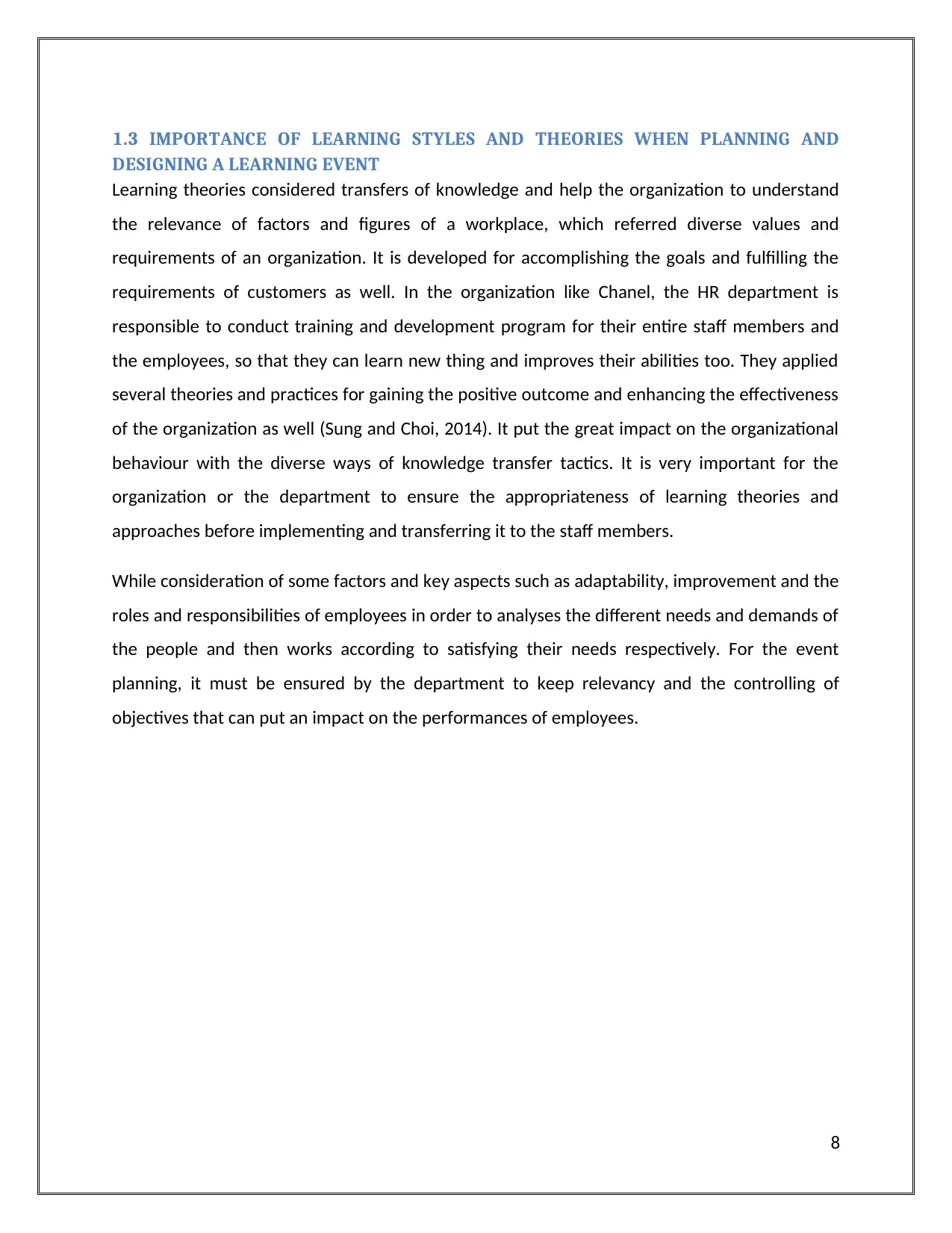
1.3 IMPORTANCE OF LEARNING STYLES AND THEORIES WHEN PLANNING AND
DESIGNING A LEARNING EVENT
Learning theories considered transfers of knowledge and help the organization to understand
the relevance of factors and figures of a workplace, which referred diverse values and
requirements of an organization. It is developed for accomplishing the goals and fulfilling the
requirements of customers as well. In the organization like Chanel, the HR department is
responsible to conduct training and development program for their entire staff members and
the employees, so that they can learn new thing and improves their abilities too. They applied
several theories and practices for gaining the positive outcome and enhancing the effectiveness
of the organization as well (Sung and Choi, 2014). It put the great impact on the organizational
behaviour with the diverse ways of knowledge transfer tactics. It is very important for the
organization or the department to ensure the appropriateness of learning theories and
approaches before implementing and transferring it to the staff members.
While consideration of some factors and key aspects such as adaptability, improvement and the
roles and responsibilities of employees in order to analyses the different needs and demands of
the people and then works according to satisfying their needs respectively. For the event
planning, it must be ensured by the department to keep relevancy and the controlling of
objectives that can put an impact on the performances of employees.
8
DESIGNING A LEARNING EVENT
Learning theories considered transfers of knowledge and help the organization to understand
the relevance of factors and figures of a workplace, which referred diverse values and
requirements of an organization. It is developed for accomplishing the goals and fulfilling the
requirements of customers as well. In the organization like Chanel, the HR department is
responsible to conduct training and development program for their entire staff members and
the employees, so that they can learn new thing and improves their abilities too. They applied
several theories and practices for gaining the positive outcome and enhancing the effectiveness
of the organization as well (Sung and Choi, 2014). It put the great impact on the organizational
behaviour with the diverse ways of knowledge transfer tactics. It is very important for the
organization or the department to ensure the appropriateness of learning theories and
approaches before implementing and transferring it to the staff members.
While consideration of some factors and key aspects such as adaptability, improvement and the
roles and responsibilities of employees in order to analyses the different needs and demands of
the people and then works according to satisfying their needs respectively. For the event
planning, it must be ensured by the department to keep relevancy and the controlling of
objectives that can put an impact on the performances of employees.
8
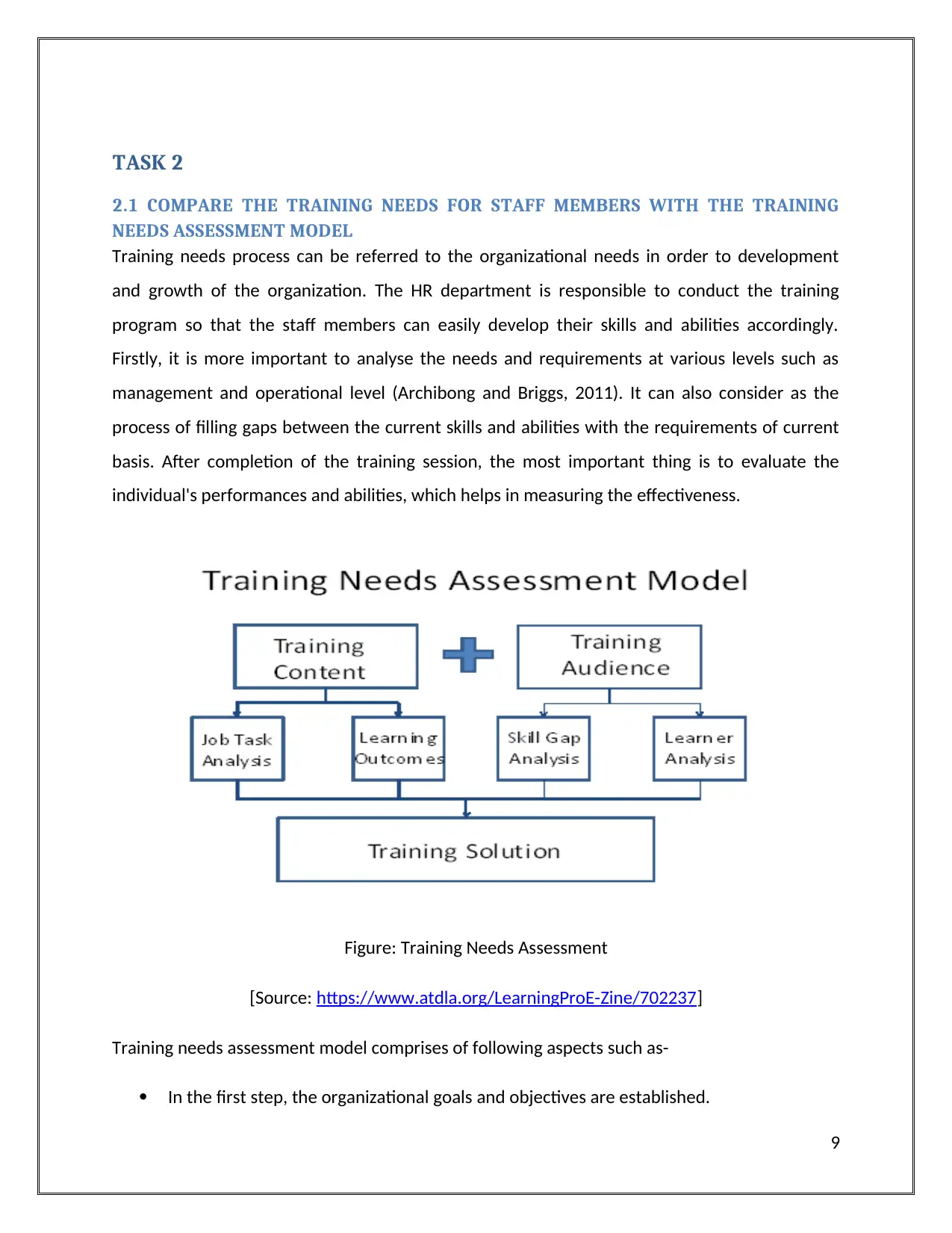
TASK 2
2.1 COMPARE THE TRAINING NEEDS FOR STAFF MEMBERS WITH THE TRAINING
NEEDS ASSESSMENT MODEL
Training needs process can be referred to the organizational needs in order to development
and growth of the organization. The HR department is responsible to conduct the training
program so that the staff members can easily develop their skills and abilities accordingly.
Firstly, it is more important to analyse the needs and requirements at various levels such as
management and operational level (Archibong and Briggs, 2011). It can also consider as the
process of filling gaps between the current skills and abilities with the requirements of current
basis. After completion of the training session, the most important thing is to evaluate the
individual's performances and abilities, which helps in measuring the effectiveness.
Figure: Training Needs Assessment
[Source: https://www.atdla.org/LearningProE-Zine/702237]
Training needs assessment model comprises of following aspects such as-
In the first step, the organizational goals and objectives are established.
9
2.1 COMPARE THE TRAINING NEEDS FOR STAFF MEMBERS WITH THE TRAINING
NEEDS ASSESSMENT MODEL
Training needs process can be referred to the organizational needs in order to development
and growth of the organization. The HR department is responsible to conduct the training
program so that the staff members can easily develop their skills and abilities accordingly.
Firstly, it is more important to analyse the needs and requirements at various levels such as
management and operational level (Archibong and Briggs, 2011). It can also consider as the
process of filling gaps between the current skills and abilities with the requirements of current
basis. After completion of the training session, the most important thing is to evaluate the
individual's performances and abilities, which helps in measuring the effectiveness.
Figure: Training Needs Assessment
[Source: https://www.atdla.org/LearningProE-Zine/702237]
Training needs assessment model comprises of following aspects such as-
In the first step, the organizational goals and objectives are established.
9
Secure Best Marks with AI Grader
Need help grading? Try our AI Grader for instant feedback on your assignments.
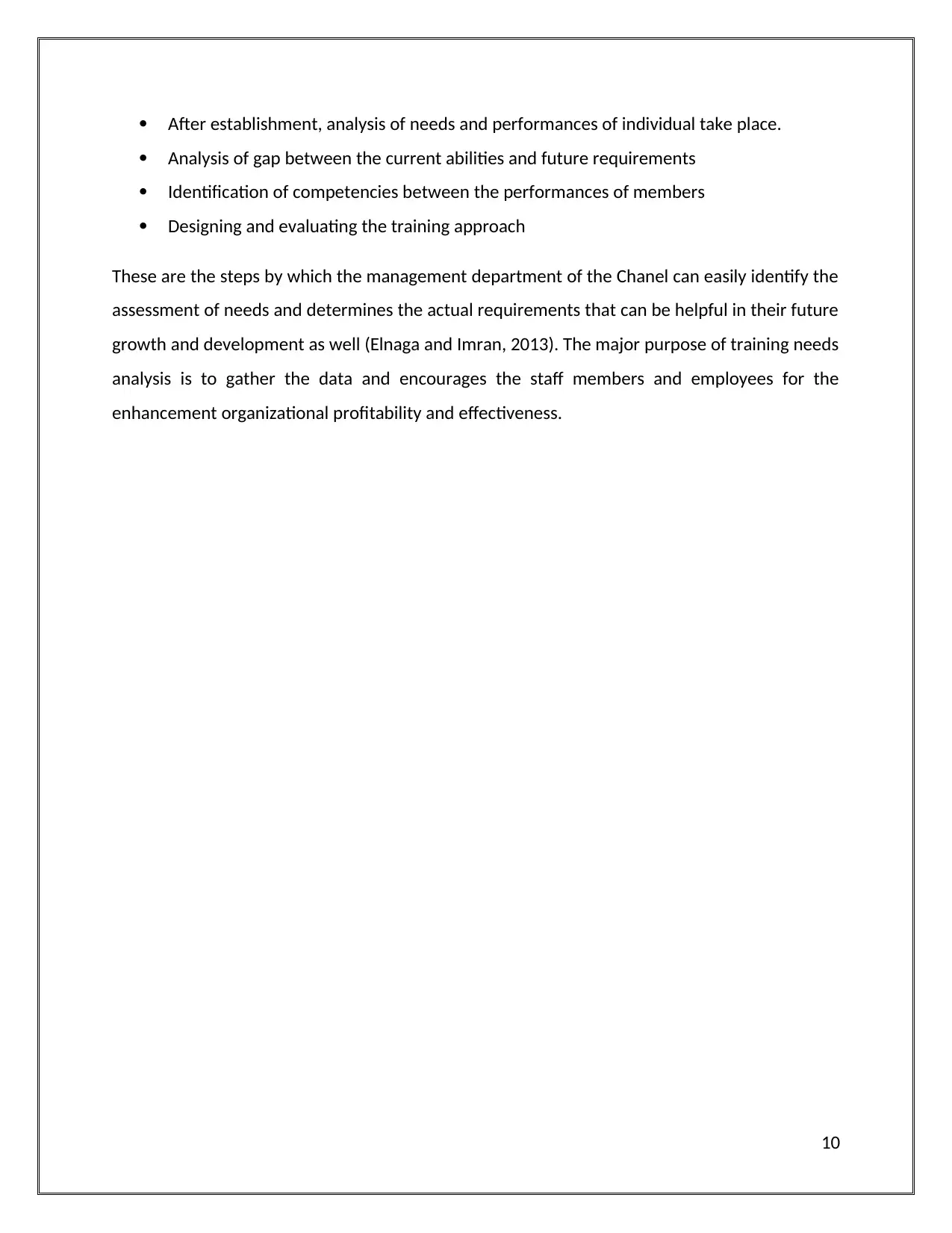
After establishment, analysis of needs and performances of individual take place.
Analysis of gap between the current abilities and future requirements
Identification of competencies between the performances of members
Designing and evaluating the training approach
These are the steps by which the management department of the Chanel can easily identify the
assessment of needs and determines the actual requirements that can be helpful in their future
growth and development as well (Elnaga and Imran, 2013). The major purpose of training needs
analysis is to gather the data and encourages the staff members and employees for the
enhancement organizational profitability and effectiveness.
10
Analysis of gap between the current abilities and future requirements
Identification of competencies between the performances of members
Designing and evaluating the training approach
These are the steps by which the management department of the Chanel can easily identify the
assessment of needs and determines the actual requirements that can be helpful in their future
growth and development as well (Elnaga and Imran, 2013). The major purpose of training needs
analysis is to gather the data and encourages the staff members and employees for the
enhancement organizational profitability and effectiveness.
10
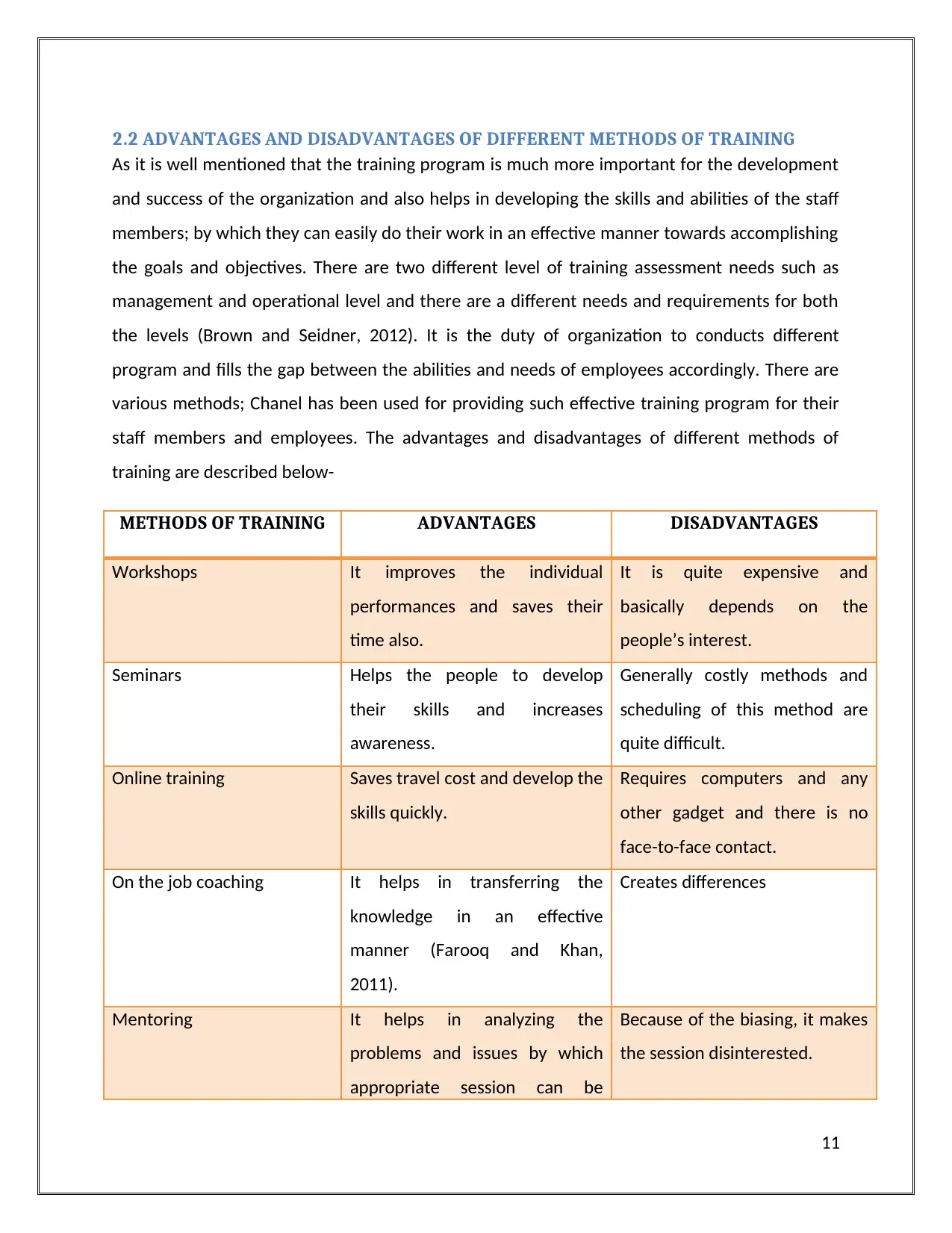
2.2 ADVANTAGES AND DISADVANTAGES OF DIFFERENT METHODS OF TRAINING
As it is well mentioned that the training program is much more important for the development
and success of the organization and also helps in developing the skills and abilities of the staff
members; by which they can easily do their work in an effective manner towards accomplishing
the goals and objectives. There are two different level of training assessment needs such as
management and operational level and there are a different needs and requirements for both
the levels (Brown and Seidner, 2012). It is the duty of organization to conducts different
program and fills the gap between the abilities and needs of employees accordingly. There are
various methods; Chanel has been used for providing such effective training program for their
staff members and employees. The advantages and disadvantages of different methods of
training are described below-
METHODS OF TRAINING ADVANTAGES DISADVANTAGES
Workshops It improves the individual
performances and saves their
time also.
It is quite expensive and
basically depends on the
people’s interest.
Seminars Helps the people to develop
their skills and increases
awareness.
Generally costly methods and
scheduling of this method are
quite difficult.
Online training Saves travel cost and develop the
skills quickly.
Requires computers and any
other gadget and there is no
face-to-face contact.
On the job coaching It helps in transferring the
knowledge in an effective
manner (Farooq and Khan,
2011).
Creates differences
Mentoring It helps in analyzing the
problems and issues by which
appropriate session can be
Because of the biasing, it makes
the session disinterested.
11
As it is well mentioned that the training program is much more important for the development
and success of the organization and also helps in developing the skills and abilities of the staff
members; by which they can easily do their work in an effective manner towards accomplishing
the goals and objectives. There are two different level of training assessment needs such as
management and operational level and there are a different needs and requirements for both
the levels (Brown and Seidner, 2012). It is the duty of organization to conducts different
program and fills the gap between the abilities and needs of employees accordingly. There are
various methods; Chanel has been used for providing such effective training program for their
staff members and employees. The advantages and disadvantages of different methods of
training are described below-
METHODS OF TRAINING ADVANTAGES DISADVANTAGES
Workshops It improves the individual
performances and saves their
time also.
It is quite expensive and
basically depends on the
people’s interest.
Seminars Helps the people to develop
their skills and increases
awareness.
Generally costly methods and
scheduling of this method are
quite difficult.
Online training Saves travel cost and develop the
skills quickly.
Requires computers and any
other gadget and there is no
face-to-face contact.
On the job coaching It helps in transferring the
knowledge in an effective
manner (Farooq and Khan,
2011).
Creates differences
Mentoring It helps in analyzing the
problems and issues by which
appropriate session can be
Because of the biasing, it makes
the session disinterested.
11
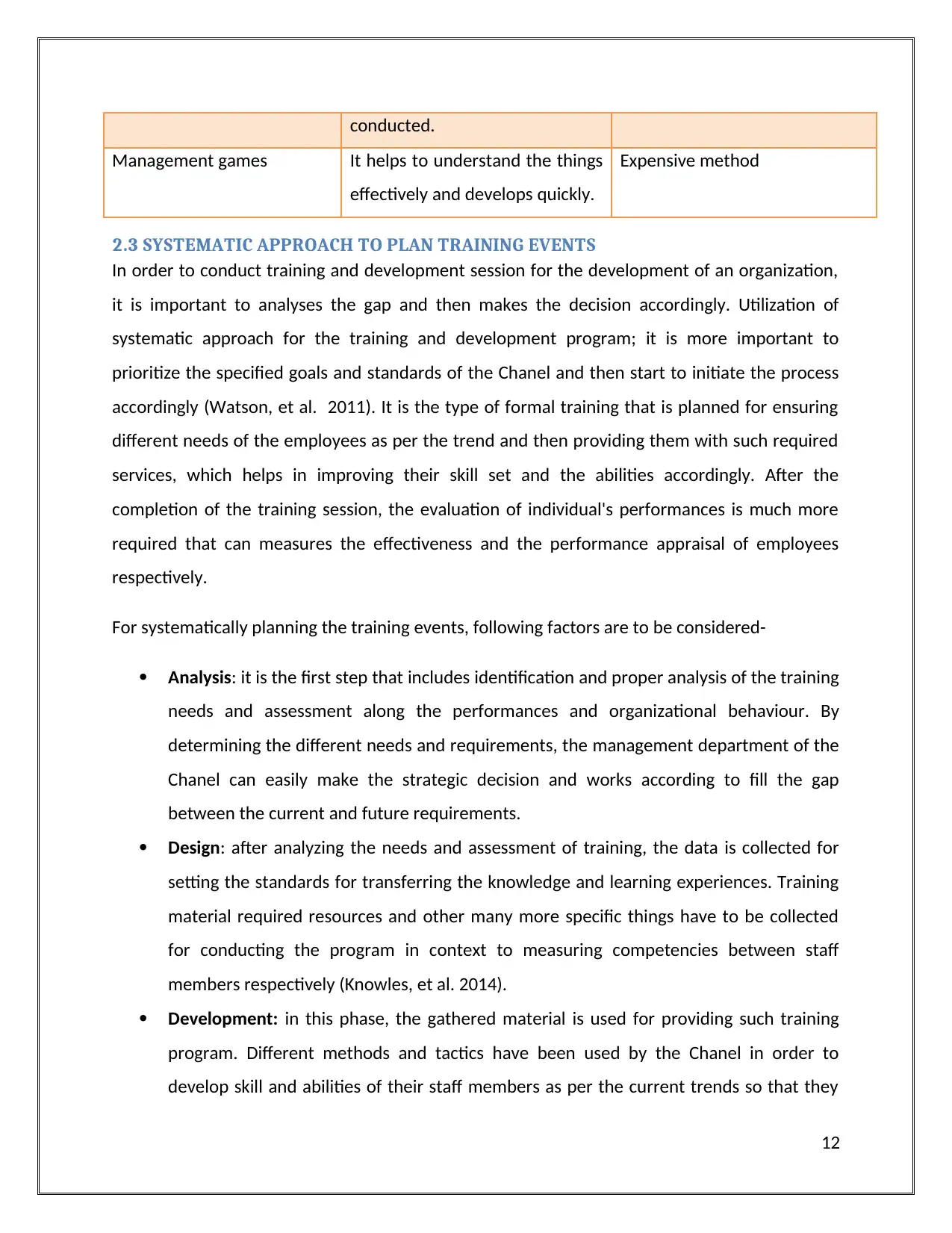
conducted.
Management games It helps to understand the things
effectively and develops quickly.
Expensive method
2.3 SYSTEMATIC APPROACH TO PLAN TRAINING EVENTS
In order to conduct training and development session for the development of an organization,
it is important to analyses the gap and then makes the decision accordingly. Utilization of
systematic approach for the training and development program; it is more important to
prioritize the specified goals and standards of the Chanel and then start to initiate the process
accordingly (Watson, et al. 2011). It is the type of formal training that is planned for ensuring
different needs of the employees as per the trend and then providing them with such required
services, which helps in improving their skill set and the abilities accordingly. After the
completion of the training session, the evaluation of individual's performances is much more
required that can measures the effectiveness and the performance appraisal of employees
respectively.
For systematically planning the training events, following factors are to be considered-
Analysis: it is the first step that includes identification and proper analysis of the training
needs and assessment along the performances and organizational behaviour. By
determining the different needs and requirements, the management department of the
Chanel can easily make the strategic decision and works according to fill the gap
between the current and future requirements.
Design: after analyzing the needs and assessment of training, the data is collected for
setting the standards for transferring the knowledge and learning experiences. Training
material required resources and other many more specific things have to be collected
for conducting the program in context to measuring competencies between staff
members respectively (Knowles, et al. 2014).
Development: in this phase, the gathered material is used for providing such training
program. Different methods and tactics have been used by the Chanel in order to
develop skill and abilities of their staff members as per the current trends so that they
12
Management games It helps to understand the things
effectively and develops quickly.
Expensive method
2.3 SYSTEMATIC APPROACH TO PLAN TRAINING EVENTS
In order to conduct training and development session for the development of an organization,
it is important to analyses the gap and then makes the decision accordingly. Utilization of
systematic approach for the training and development program; it is more important to
prioritize the specified goals and standards of the Chanel and then start to initiate the process
accordingly (Watson, et al. 2011). It is the type of formal training that is planned for ensuring
different needs of the employees as per the trend and then providing them with such required
services, which helps in improving their skill set and the abilities accordingly. After the
completion of the training session, the evaluation of individual's performances is much more
required that can measures the effectiveness and the performance appraisal of employees
respectively.
For systematically planning the training events, following factors are to be considered-
Analysis: it is the first step that includes identification and proper analysis of the training
needs and assessment along the performances and organizational behaviour. By
determining the different needs and requirements, the management department of the
Chanel can easily make the strategic decision and works according to fill the gap
between the current and future requirements.
Design: after analyzing the needs and assessment of training, the data is collected for
setting the standards for transferring the knowledge and learning experiences. Training
material required resources and other many more specific things have to be collected
for conducting the program in context to measuring competencies between staff
members respectively (Knowles, et al. 2014).
Development: in this phase, the gathered material is used for providing such training
program. Different methods and tactics have been used by the Chanel in order to
develop skill and abilities of their staff members as per the current trends so that they
12
Paraphrase This Document
Need a fresh take? Get an instant paraphrase of this document with our AI Paraphraser
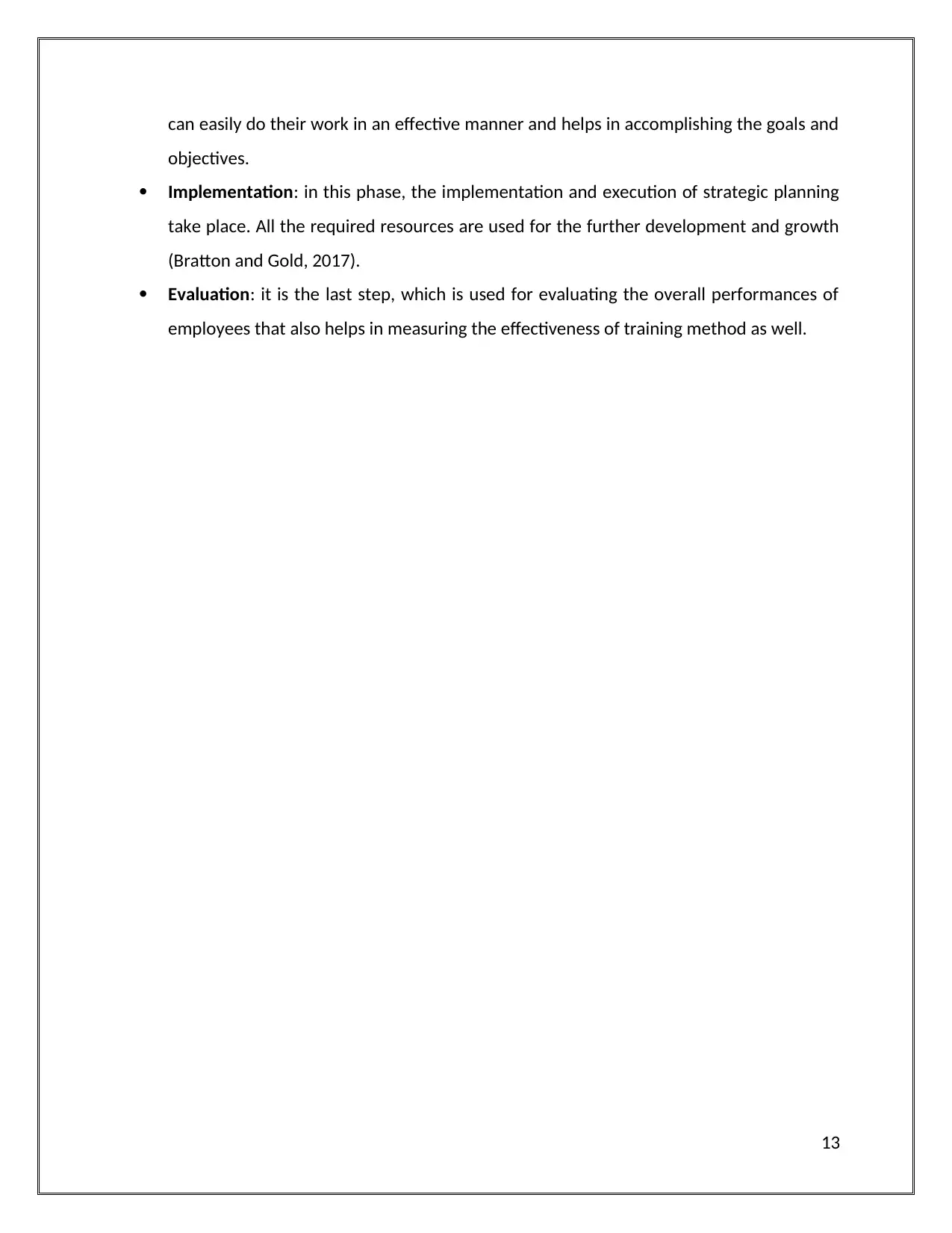
can easily do their work in an effective manner and helps in accomplishing the goals and
objectives.
Implementation: in this phase, the implementation and execution of strategic planning
take place. All the required resources are used for the further development and growth
(Bratton and Gold, 2017).
Evaluation: it is the last step, which is used for evaluating the overall performances of
employees that also helps in measuring the effectiveness of training method as well.
13
objectives.
Implementation: in this phase, the implementation and execution of strategic planning
take place. All the required resources are used for the further development and growth
(Bratton and Gold, 2017).
Evaluation: it is the last step, which is used for evaluating the overall performances of
employees that also helps in measuring the effectiveness of training method as well.
13
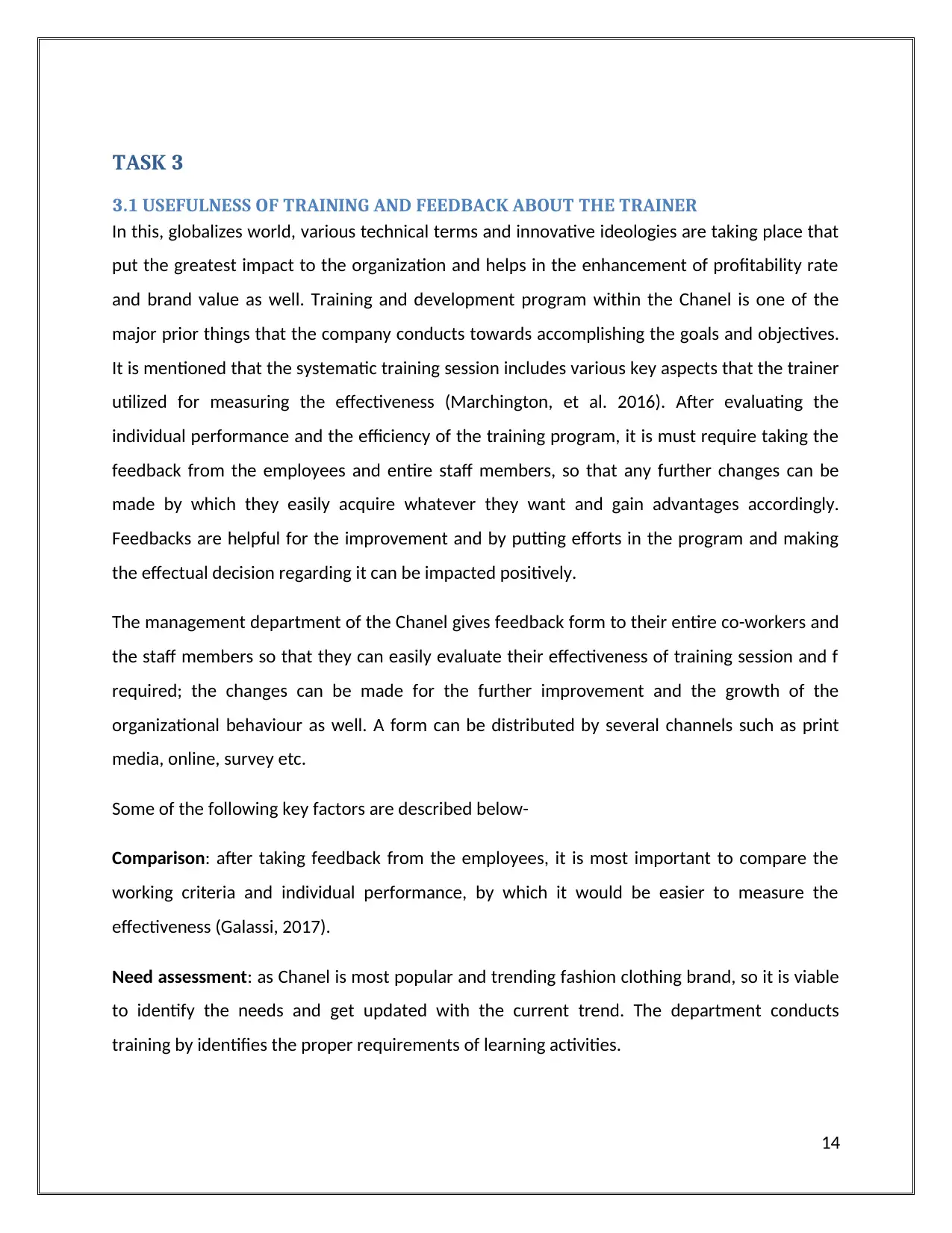
TASK 3
3.1 USEFULNESS OF TRAINING AND FEEDBACK ABOUT THE TRAINER
In this, globalizes world, various technical terms and innovative ideologies are taking place that
put the greatest impact to the organization and helps in the enhancement of profitability rate
and brand value as well. Training and development program within the Chanel is one of the
major prior things that the company conducts towards accomplishing the goals and objectives.
It is mentioned that the systematic training session includes various key aspects that the trainer
utilized for measuring the effectiveness (Marchington, et al. 2016). After evaluating the
individual performance and the efficiency of the training program, it is must require taking the
feedback from the employees and entire staff members, so that any further changes can be
made by which they easily acquire whatever they want and gain advantages accordingly.
Feedbacks are helpful for the improvement and by putting efforts in the program and making
the effectual decision regarding it can be impacted positively.
The management department of the Chanel gives feedback form to their entire co-workers and
the staff members so that they can easily evaluate their effectiveness of training session and f
required; the changes can be made for the further improvement and the growth of the
organizational behaviour as well. A form can be distributed by several channels such as print
media, online, survey etc.
Some of the following key factors are described below-
Comparison: after taking feedback from the employees, it is most important to compare the
working criteria and individual performance, by which it would be easier to measure the
effectiveness (Galassi, 2017).
Need assessment: as Chanel is most popular and trending fashion clothing brand, so it is viable
to identify the needs and get updated with the current trend. The department conducts
training by identifies the proper requirements of learning activities.
14
3.1 USEFULNESS OF TRAINING AND FEEDBACK ABOUT THE TRAINER
In this, globalizes world, various technical terms and innovative ideologies are taking place that
put the greatest impact to the organization and helps in the enhancement of profitability rate
and brand value as well. Training and development program within the Chanel is one of the
major prior things that the company conducts towards accomplishing the goals and objectives.
It is mentioned that the systematic training session includes various key aspects that the trainer
utilized for measuring the effectiveness (Marchington, et al. 2016). After evaluating the
individual performance and the efficiency of the training program, it is must require taking the
feedback from the employees and entire staff members, so that any further changes can be
made by which they easily acquire whatever they want and gain advantages accordingly.
Feedbacks are helpful for the improvement and by putting efforts in the program and making
the effectual decision regarding it can be impacted positively.
The management department of the Chanel gives feedback form to their entire co-workers and
the staff members so that they can easily evaluate their effectiveness of training session and f
required; the changes can be made for the further improvement and the growth of the
organizational behaviour as well. A form can be distributed by several channels such as print
media, online, survey etc.
Some of the following key factors are described below-
Comparison: after taking feedback from the employees, it is most important to compare the
working criteria and individual performance, by which it would be easier to measure the
effectiveness (Galassi, 2017).
Need assessment: as Chanel is most popular and trending fashion clothing brand, so it is viable
to identify the needs and get updated with the current trend. The department conducts
training by identifies the proper requirements of learning activities.
14
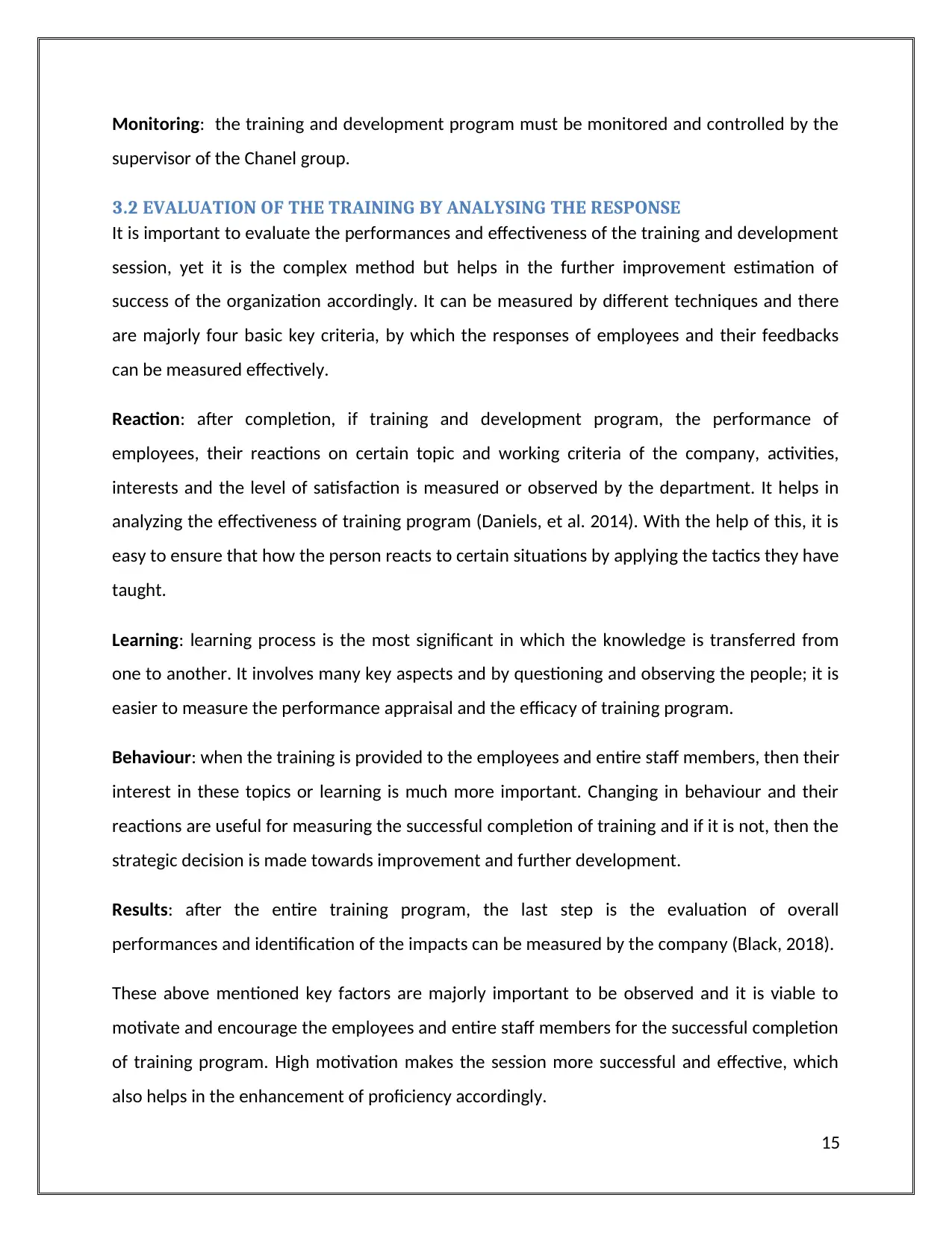
Monitoring: the training and development program must be monitored and controlled by the
supervisor of the Chanel group.
3.2 EVALUATION OF THE TRAINING BY ANALYSING THE RESPONSE
It is important to evaluate the performances and effectiveness of the training and development
session, yet it is the complex method but helps in the further improvement estimation of
success of the organization accordingly. It can be measured by different techniques and there
are majorly four basic key criteria, by which the responses of employees and their feedbacks
can be measured effectively.
Reaction: after completion, if training and development program, the performance of
employees, their reactions on certain topic and working criteria of the company, activities,
interests and the level of satisfaction is measured or observed by the department. It helps in
analyzing the effectiveness of training program (Daniels, et al. 2014). With the help of this, it is
easy to ensure that how the person reacts to certain situations by applying the tactics they have
taught.
Learning: learning process is the most significant in which the knowledge is transferred from
one to another. It involves many key aspects and by questioning and observing the people; it is
easier to measure the performance appraisal and the efficacy of training program.
Behaviour: when the training is provided to the employees and entire staff members, then their
interest in these topics or learning is much more important. Changing in behaviour and their
reactions are useful for measuring the successful completion of training and if it is not, then the
strategic decision is made towards improvement and further development.
Results: after the entire training program, the last step is the evaluation of overall
performances and identification of the impacts can be measured by the company (Black, 2018).
These above mentioned key factors are majorly important to be observed and it is viable to
motivate and encourage the employees and entire staff members for the successful completion
of training program. High motivation makes the session more successful and effective, which
also helps in the enhancement of proficiency accordingly.
15
supervisor of the Chanel group.
3.2 EVALUATION OF THE TRAINING BY ANALYSING THE RESPONSE
It is important to evaluate the performances and effectiveness of the training and development
session, yet it is the complex method but helps in the further improvement estimation of
success of the organization accordingly. It can be measured by different techniques and there
are majorly four basic key criteria, by which the responses of employees and their feedbacks
can be measured effectively.
Reaction: after completion, if training and development program, the performance of
employees, their reactions on certain topic and working criteria of the company, activities,
interests and the level of satisfaction is measured or observed by the department. It helps in
analyzing the effectiveness of training program (Daniels, et al. 2014). With the help of this, it is
easy to ensure that how the person reacts to certain situations by applying the tactics they have
taught.
Learning: learning process is the most significant in which the knowledge is transferred from
one to another. It involves many key aspects and by questioning and observing the people; it is
easier to measure the performance appraisal and the efficacy of training program.
Behaviour: when the training is provided to the employees and entire staff members, then their
interest in these topics or learning is much more important. Changing in behaviour and their
reactions are useful for measuring the successful completion of training and if it is not, then the
strategic decision is made towards improvement and further development.
Results: after the entire training program, the last step is the evaluation of overall
performances and identification of the impacts can be measured by the company (Black, 2018).
These above mentioned key factors are majorly important to be observed and it is viable to
motivate and encourage the employees and entire staff members for the successful completion
of training program. High motivation makes the session more successful and effective, which
also helps in the enhancement of proficiency accordingly.
15
Secure Best Marks with AI Grader
Need help grading? Try our AI Grader for instant feedback on your assignments.

16
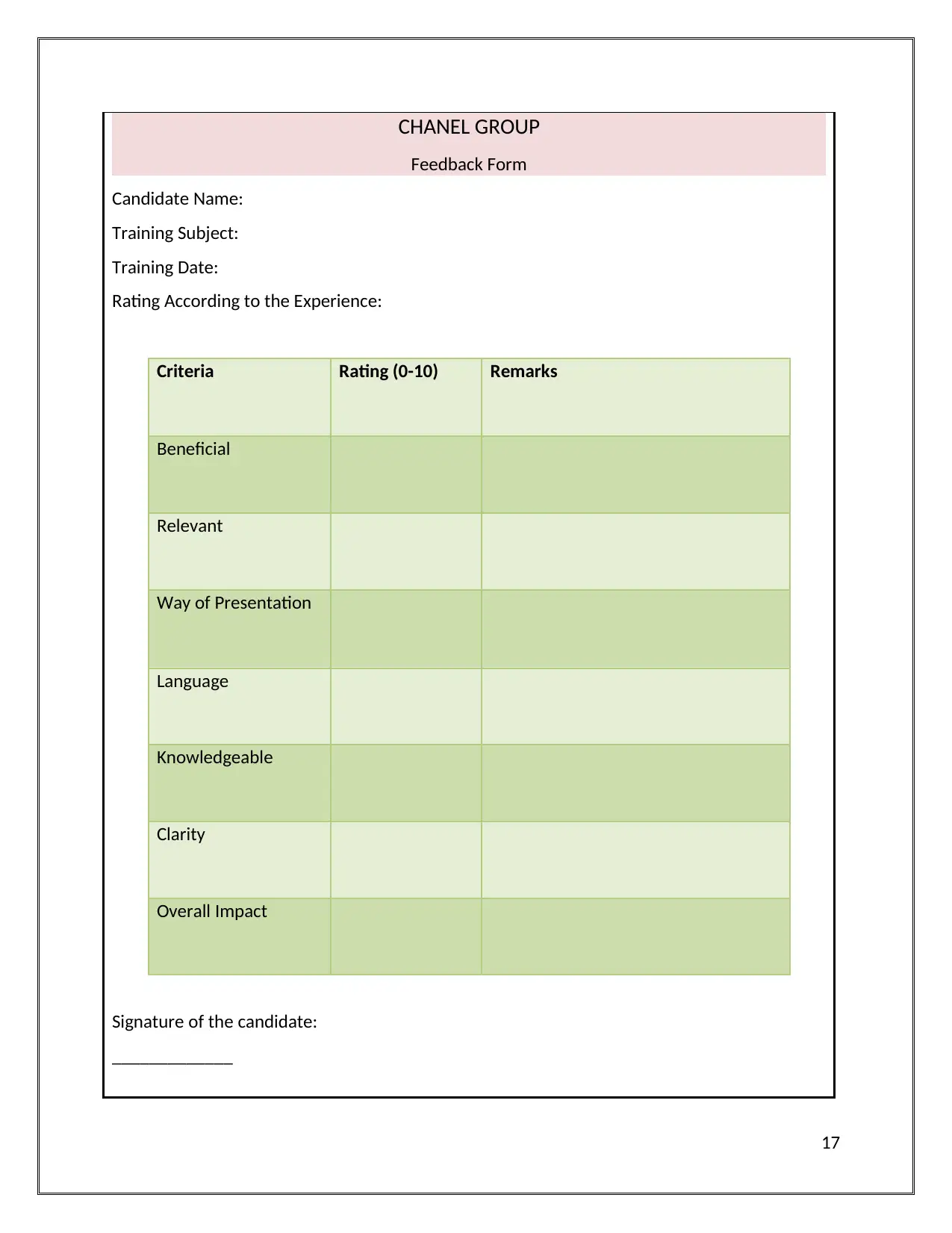
CHANEL GROUP
Feedback Form
Candidate Name:
Training Subject:
Training Date:
Rating According to the Experience:
Criteria Rating (0-10) Remarks
Beneficial
Relevant
Way of Presentation
Language
Knowledgeable
Clarity
Overall Impact
Signature of the candidate:
_____________
17
Feedback Form
Candidate Name:
Training Subject:
Training Date:
Rating According to the Experience:
Criteria Rating (0-10) Remarks
Beneficial
Relevant
Way of Presentation
Language
Knowledgeable
Clarity
Overall Impact
Signature of the candidate:
_____________
17
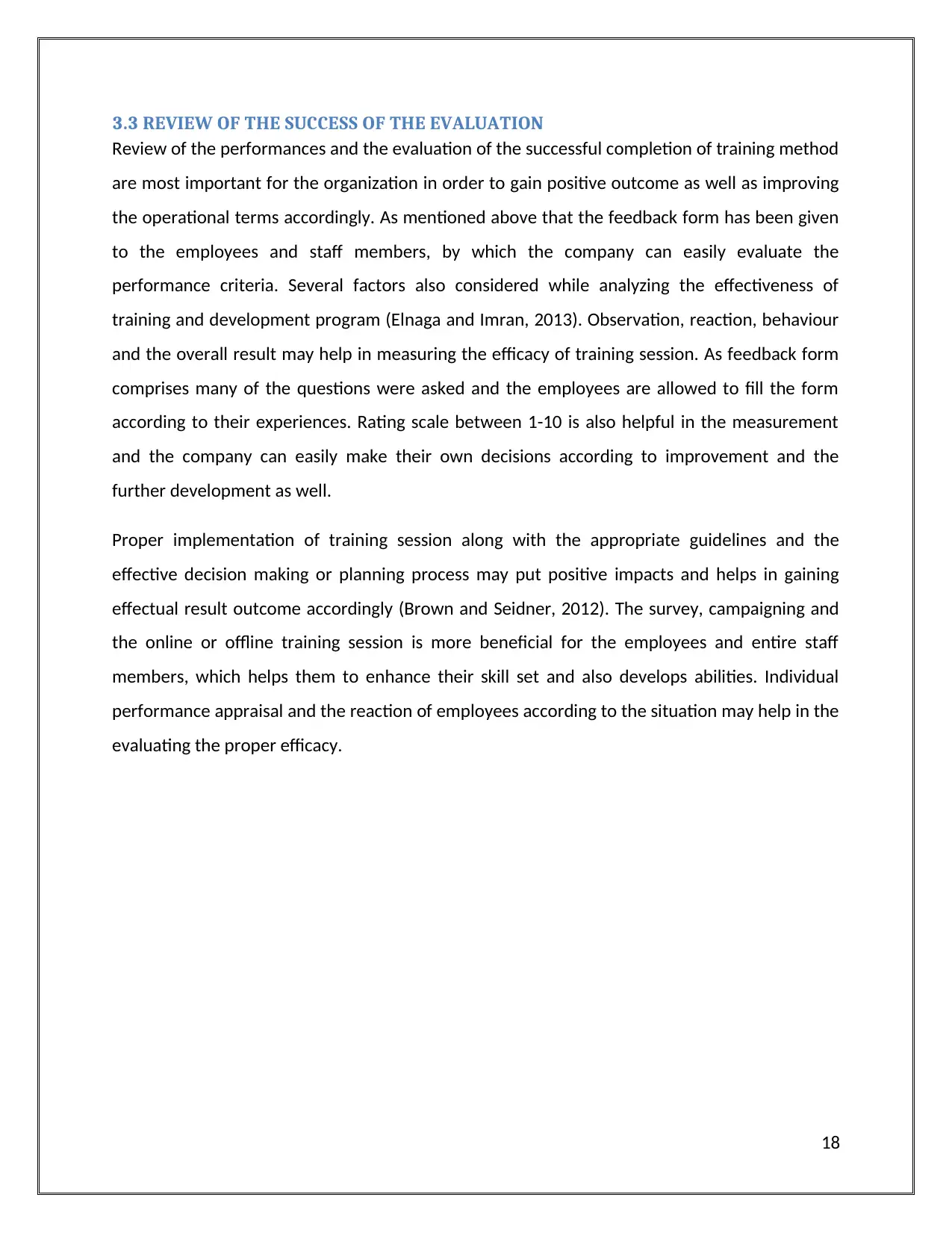
3.3 REVIEW OF THE SUCCESS OF THE EVALUATION
Review of the performances and the evaluation of the successful completion of training method
are most important for the organization in order to gain positive outcome as well as improving
the operational terms accordingly. As mentioned above that the feedback form has been given
to the employees and staff members, by which the company can easily evaluate the
performance criteria. Several factors also considered while analyzing the effectiveness of
training and development program (Elnaga and Imran, 2013). Observation, reaction, behaviour
and the overall result may help in measuring the efficacy of training session. As feedback form
comprises many of the questions were asked and the employees are allowed to fill the form
according to their experiences. Rating scale between 1-10 is also helpful in the measurement
and the company can easily make their own decisions according to improvement and the
further development as well.
Proper implementation of training session along with the appropriate guidelines and the
effective decision making or planning process may put positive impacts and helps in gaining
effectual result outcome accordingly (Brown and Seidner, 2012). The survey, campaigning and
the online or offline training session is more beneficial for the employees and entire staff
members, which helps them to enhance their skill set and also develops abilities. Individual
performance appraisal and the reaction of employees according to the situation may help in the
evaluating the proper efficacy.
18
Review of the performances and the evaluation of the successful completion of training method
are most important for the organization in order to gain positive outcome as well as improving
the operational terms accordingly. As mentioned above that the feedback form has been given
to the employees and staff members, by which the company can easily evaluate the
performance criteria. Several factors also considered while analyzing the effectiveness of
training and development program (Elnaga and Imran, 2013). Observation, reaction, behaviour
and the overall result may help in measuring the efficacy of training session. As feedback form
comprises many of the questions were asked and the employees are allowed to fill the form
according to their experiences. Rating scale between 1-10 is also helpful in the measurement
and the company can easily make their own decisions according to improvement and the
further development as well.
Proper implementation of training session along with the appropriate guidelines and the
effective decision making or planning process may put positive impacts and helps in gaining
effectual result outcome accordingly (Brown and Seidner, 2012). The survey, campaigning and
the online or offline training session is more beneficial for the employees and entire staff
members, which helps them to enhance their skill set and also develops abilities. Individual
performance appraisal and the reaction of employees according to the situation may help in the
evaluating the proper efficacy.
18
Paraphrase This Document
Need a fresh take? Get an instant paraphrase of this document with our AI Paraphraser
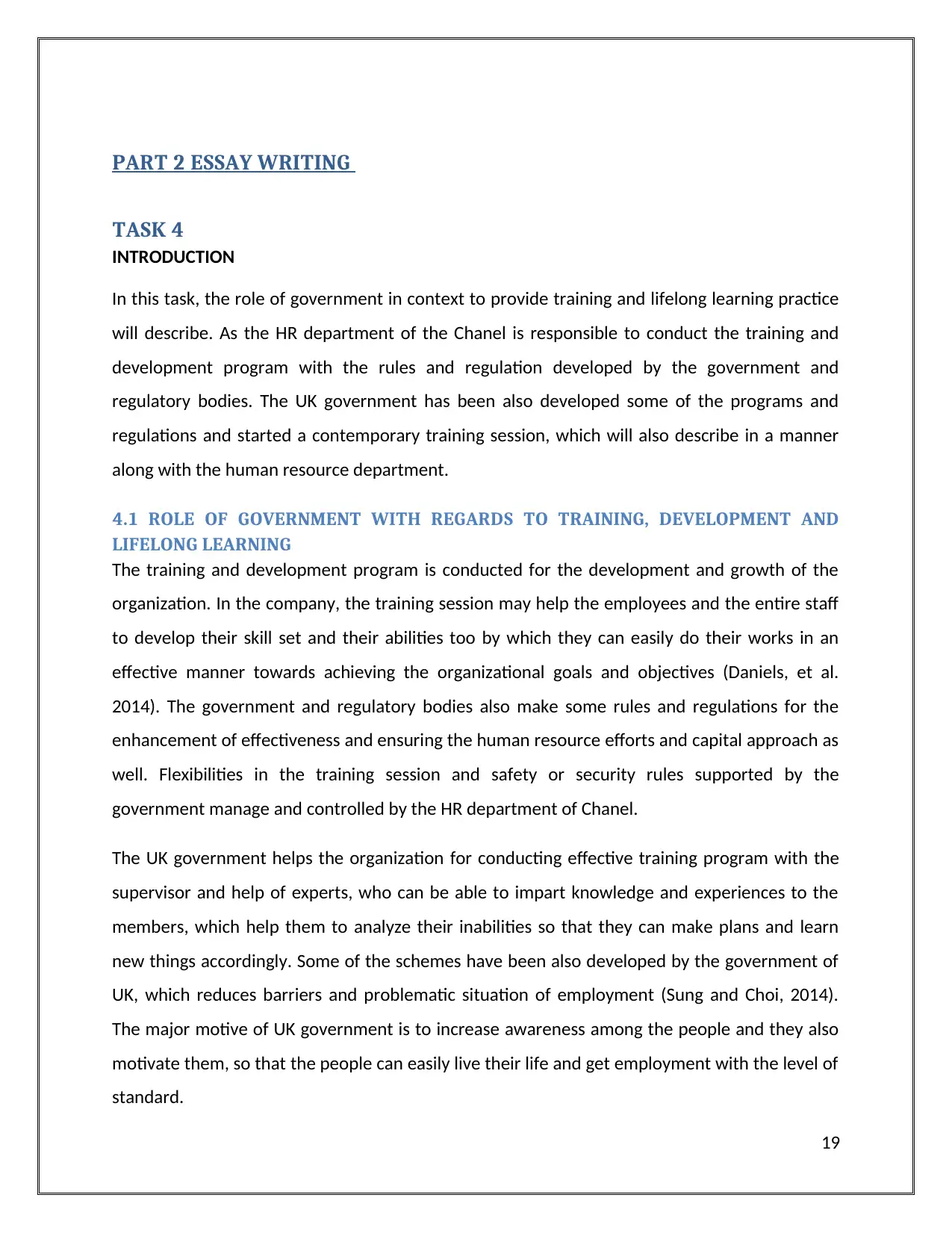
PART 2 ESSAY WRITING
TASK 4
INTRODUCTION
In this task, the role of government in context to provide training and lifelong learning practice
will describe. As the HR department of the Chanel is responsible to conduct the training and
development program with the rules and regulation developed by the government and
regulatory bodies. The UK government has been also developed some of the programs and
regulations and started a contemporary training session, which will also describe in a manner
along with the human resource department.
4.1 ROLE OF GOVERNMENT WITH REGARDS TO TRAINING, DEVELOPMENT AND
LIFELONG LEARNING
The training and development program is conducted for the development and growth of the
organization. In the company, the training session may help the employees and the entire staff
to develop their skill set and their abilities too by which they can easily do their works in an
effective manner towards achieving the organizational goals and objectives (Daniels, et al.
2014). The government and regulatory bodies also make some rules and regulations for the
enhancement of effectiveness and ensuring the human resource efforts and capital approach as
well. Flexibilities in the training session and safety or security rules supported by the
government manage and controlled by the HR department of Chanel.
The UK government helps the organization for conducting effective training program with the
supervisor and help of experts, who can be able to impart knowledge and experiences to the
members, which help them to analyze their inabilities so that they can make plans and learn
new things accordingly. Some of the schemes have been also developed by the government of
UK, which reduces barriers and problematic situation of employment (Sung and Choi, 2014).
The major motive of UK government is to increase awareness among the people and they also
motivate them, so that the people can easily live their life and get employment with the level of
standard.
19
TASK 4
INTRODUCTION
In this task, the role of government in context to provide training and lifelong learning practice
will describe. As the HR department of the Chanel is responsible to conduct the training and
development program with the rules and regulation developed by the government and
regulatory bodies. The UK government has been also developed some of the programs and
regulations and started a contemporary training session, which will also describe in a manner
along with the human resource department.
4.1 ROLE OF GOVERNMENT WITH REGARDS TO TRAINING, DEVELOPMENT AND
LIFELONG LEARNING
The training and development program is conducted for the development and growth of the
organization. In the company, the training session may help the employees and the entire staff
to develop their skill set and their abilities too by which they can easily do their works in an
effective manner towards achieving the organizational goals and objectives (Daniels, et al.
2014). The government and regulatory bodies also make some rules and regulations for the
enhancement of effectiveness and ensuring the human resource efforts and capital approach as
well. Flexibilities in the training session and safety or security rules supported by the
government manage and controlled by the HR department of Chanel.
The UK government helps the organization for conducting effective training program with the
supervisor and help of experts, who can be able to impart knowledge and experiences to the
members, which help them to analyze their inabilities so that they can make plans and learn
new things accordingly. Some of the schemes have been also developed by the government of
UK, which reduces barriers and problematic situation of employment (Sung and Choi, 2014).
The major motive of UK government is to increase awareness among the people and they also
motivate them, so that the people can easily live their life and get employment with the level of
standard.
19
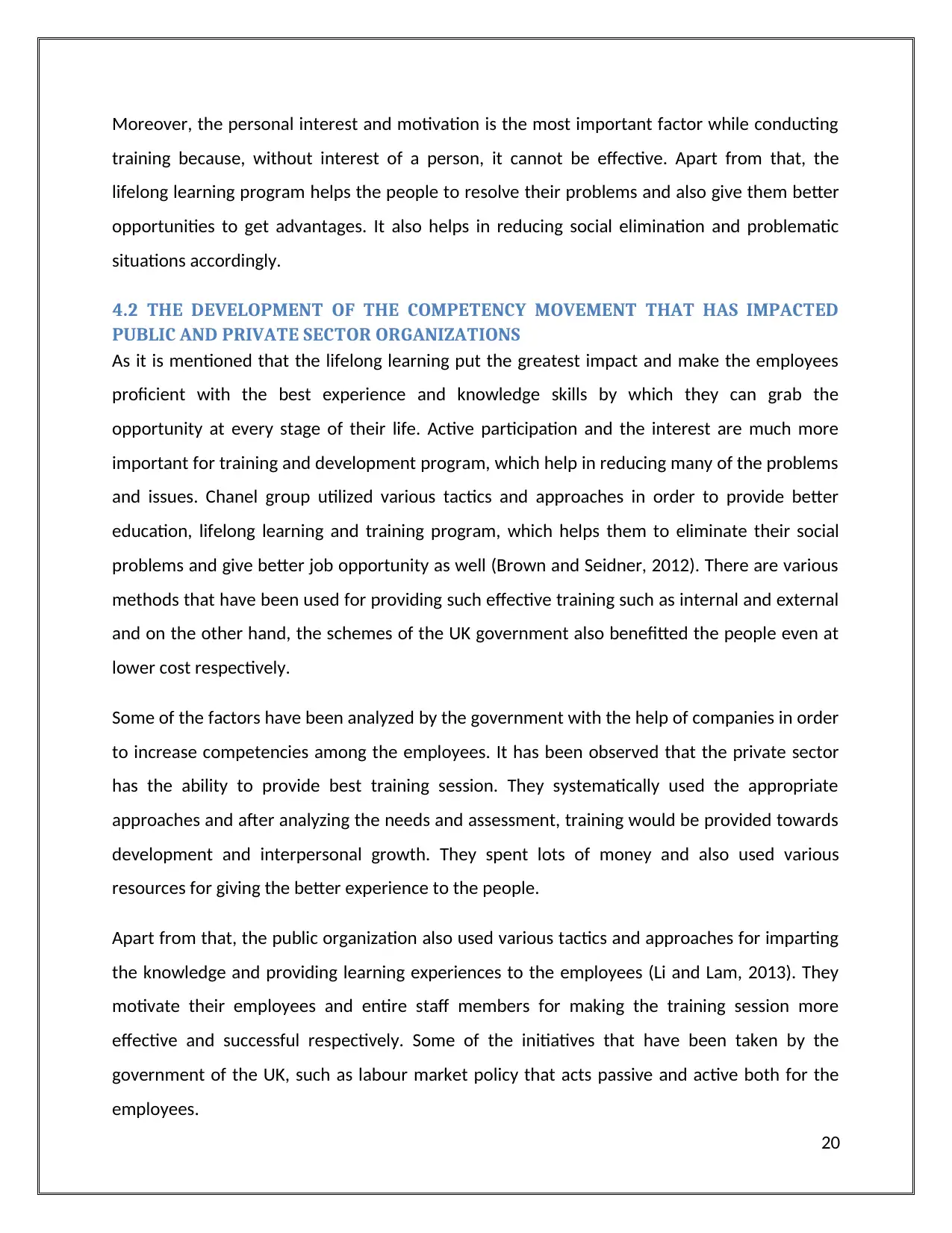
Moreover, the personal interest and motivation is the most important factor while conducting
training because, without interest of a person, it cannot be effective. Apart from that, the
lifelong learning program helps the people to resolve their problems and also give them better
opportunities to get advantages. It also helps in reducing social elimination and problematic
situations accordingly.
4.2 THE DEVELOPMENT OF THE COMPETENCY MOVEMENT THAT HAS IMPACTED
PUBLIC AND PRIVATE SECTOR ORGANIZATIONS
As it is mentioned that the lifelong learning put the greatest impact and make the employees
proficient with the best experience and knowledge skills by which they can grab the
opportunity at every stage of their life. Active participation and the interest are much more
important for training and development program, which help in reducing many of the problems
and issues. Chanel group utilized various tactics and approaches in order to provide better
education, lifelong learning and training program, which helps them to eliminate their social
problems and give better job opportunity as well (Brown and Seidner, 2012). There are various
methods that have been used for providing such effective training such as internal and external
and on the other hand, the schemes of the UK government also benefitted the people even at
lower cost respectively.
Some of the factors have been analyzed by the government with the help of companies in order
to increase competencies among the employees. It has been observed that the private sector
has the ability to provide best training session. They systematically used the appropriate
approaches and after analyzing the needs and assessment, training would be provided towards
development and interpersonal growth. They spent lots of money and also used various
resources for giving the better experience to the people.
Apart from that, the public organization also used various tactics and approaches for imparting
the knowledge and providing learning experiences to the employees (Li and Lam, 2013). They
motivate their employees and entire staff members for making the training session more
effective and successful respectively. Some of the initiatives that have been taken by the
government of the UK, such as labour market policy that acts passive and active both for the
employees.
20
training because, without interest of a person, it cannot be effective. Apart from that, the
lifelong learning program helps the people to resolve their problems and also give them better
opportunities to get advantages. It also helps in reducing social elimination and problematic
situations accordingly.
4.2 THE DEVELOPMENT OF THE COMPETENCY MOVEMENT THAT HAS IMPACTED
PUBLIC AND PRIVATE SECTOR ORGANIZATIONS
As it is mentioned that the lifelong learning put the greatest impact and make the employees
proficient with the best experience and knowledge skills by which they can grab the
opportunity at every stage of their life. Active participation and the interest are much more
important for training and development program, which help in reducing many of the problems
and issues. Chanel group utilized various tactics and approaches in order to provide better
education, lifelong learning and training program, which helps them to eliminate their social
problems and give better job opportunity as well (Brown and Seidner, 2012). There are various
methods that have been used for providing such effective training such as internal and external
and on the other hand, the schemes of the UK government also benefitted the people even at
lower cost respectively.
Some of the factors have been analyzed by the government with the help of companies in order
to increase competencies among the employees. It has been observed that the private sector
has the ability to provide best training session. They systematically used the appropriate
approaches and after analyzing the needs and assessment, training would be provided towards
development and interpersonal growth. They spent lots of money and also used various
resources for giving the better experience to the people.
Apart from that, the public organization also used various tactics and approaches for imparting
the knowledge and providing learning experiences to the employees (Li and Lam, 2013). They
motivate their employees and entire staff members for making the training session more
effective and successful respectively. Some of the initiatives that have been taken by the
government of the UK, such as labour market policy that acts passive and active both for the
employees.
20
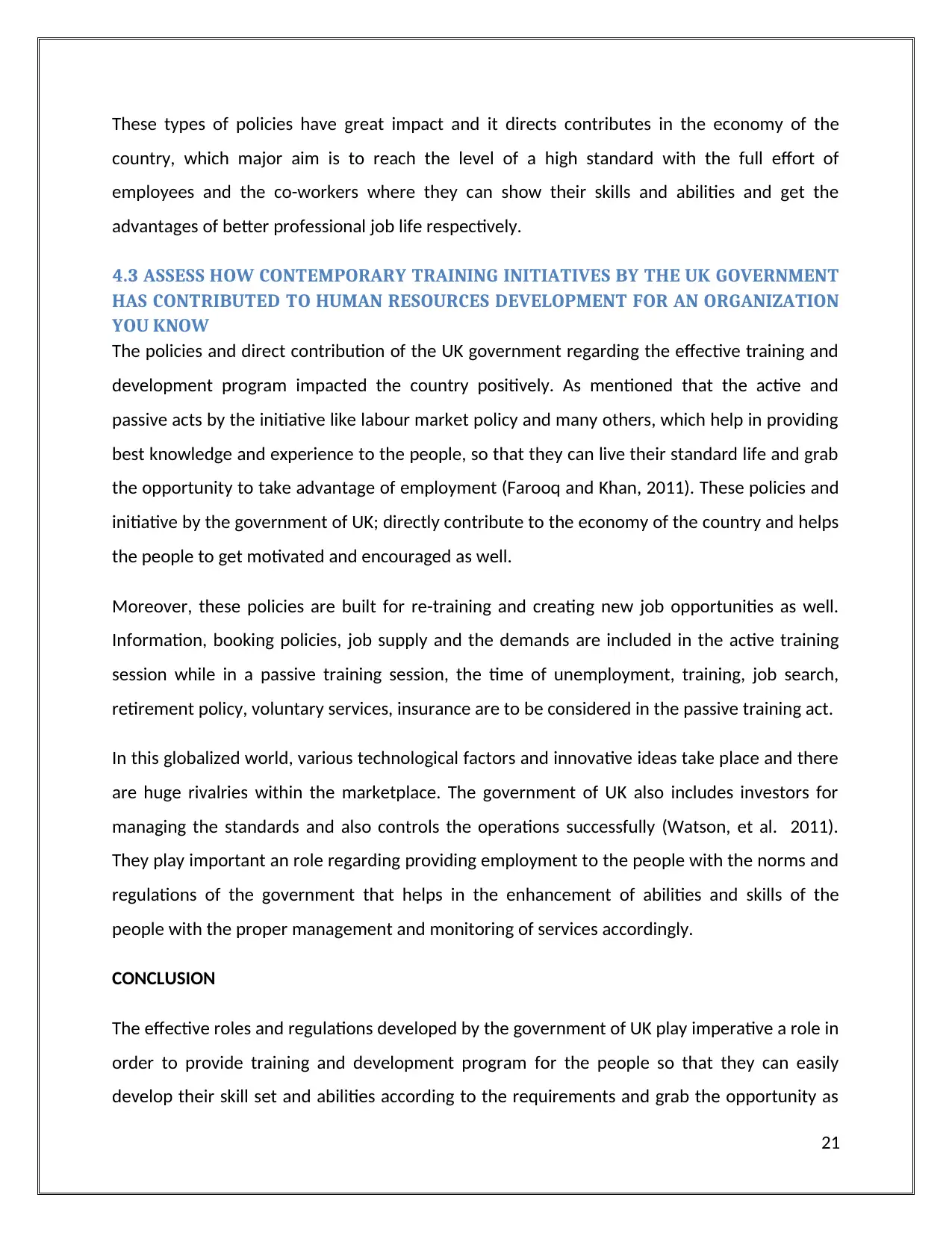
These types of policies have great impact and it directs contributes in the economy of the
country, which major aim is to reach the level of a high standard with the full effort of
employees and the co-workers where they can show their skills and abilities and get the
advantages of better professional job life respectively.
4.3 ASSESS HOW CONTEMPORARY TRAINING INITIATIVES BY THE UK GOVERNMENT
HAS CONTRIBUTED TO HUMAN RESOURCES DEVELOPMENT FOR AN ORGANIZATION
YOU KNOW
The policies and direct contribution of the UK government regarding the effective training and
development program impacted the country positively. As mentioned that the active and
passive acts by the initiative like labour market policy and many others, which help in providing
best knowledge and experience to the people, so that they can live their standard life and grab
the opportunity to take advantage of employment (Farooq and Khan, 2011). These policies and
initiative by the government of UK; directly contribute to the economy of the country and helps
the people to get motivated and encouraged as well.
Moreover, these policies are built for re-training and creating new job opportunities as well.
Information, booking policies, job supply and the demands are included in the active training
session while in a passive training session, the time of unemployment, training, job search,
retirement policy, voluntary services, insurance are to be considered in the passive training act.
In this globalized world, various technological factors and innovative ideas take place and there
are huge rivalries within the marketplace. The government of UK also includes investors for
managing the standards and also controls the operations successfully (Watson, et al. 2011).
They play important an role regarding providing employment to the people with the norms and
regulations of the government that helps in the enhancement of abilities and skills of the
people with the proper management and monitoring of services accordingly.
CONCLUSION
The effective roles and regulations developed by the government of UK play imperative a role in
order to provide training and development program for the people so that they can easily
develop their skill set and abilities according to the requirements and grab the opportunity as
21
country, which major aim is to reach the level of a high standard with the full effort of
employees and the co-workers where they can show their skills and abilities and get the
advantages of better professional job life respectively.
4.3 ASSESS HOW CONTEMPORARY TRAINING INITIATIVES BY THE UK GOVERNMENT
HAS CONTRIBUTED TO HUMAN RESOURCES DEVELOPMENT FOR AN ORGANIZATION
YOU KNOW
The policies and direct contribution of the UK government regarding the effective training and
development program impacted the country positively. As mentioned that the active and
passive acts by the initiative like labour market policy and many others, which help in providing
best knowledge and experience to the people, so that they can live their standard life and grab
the opportunity to take advantage of employment (Farooq and Khan, 2011). These policies and
initiative by the government of UK; directly contribute to the economy of the country and helps
the people to get motivated and encouraged as well.
Moreover, these policies are built for re-training and creating new job opportunities as well.
Information, booking policies, job supply and the demands are included in the active training
session while in a passive training session, the time of unemployment, training, job search,
retirement policy, voluntary services, insurance are to be considered in the passive training act.
In this globalized world, various technological factors and innovative ideas take place and there
are huge rivalries within the marketplace. The government of UK also includes investors for
managing the standards and also controls the operations successfully (Watson, et al. 2011).
They play important an role regarding providing employment to the people with the norms and
regulations of the government that helps in the enhancement of abilities and skills of the
people with the proper management and monitoring of services accordingly.
CONCLUSION
The effective roles and regulations developed by the government of UK play imperative a role in
order to provide training and development program for the people so that they can easily
develop their skill set and abilities according to the requirements and grab the opportunity as
21
Secure Best Marks with AI Grader
Need help grading? Try our AI Grader for instant feedback on your assignments.
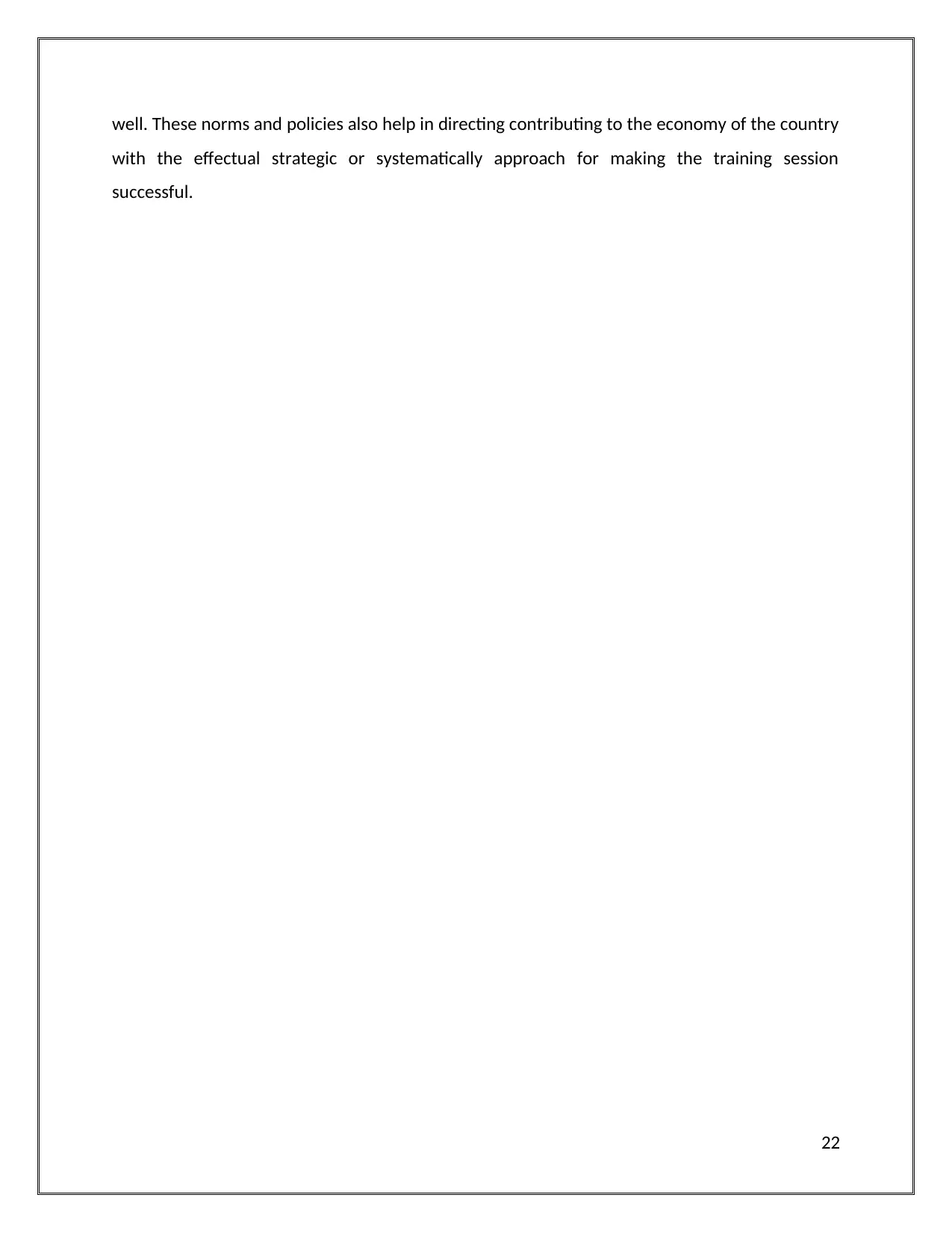
well. These norms and policies also help in directing contributing to the economy of the country
with the effectual strategic or systematically approach for making the training session
successful.
22
with the effectual strategic or systematically approach for making the training session
successful.
22
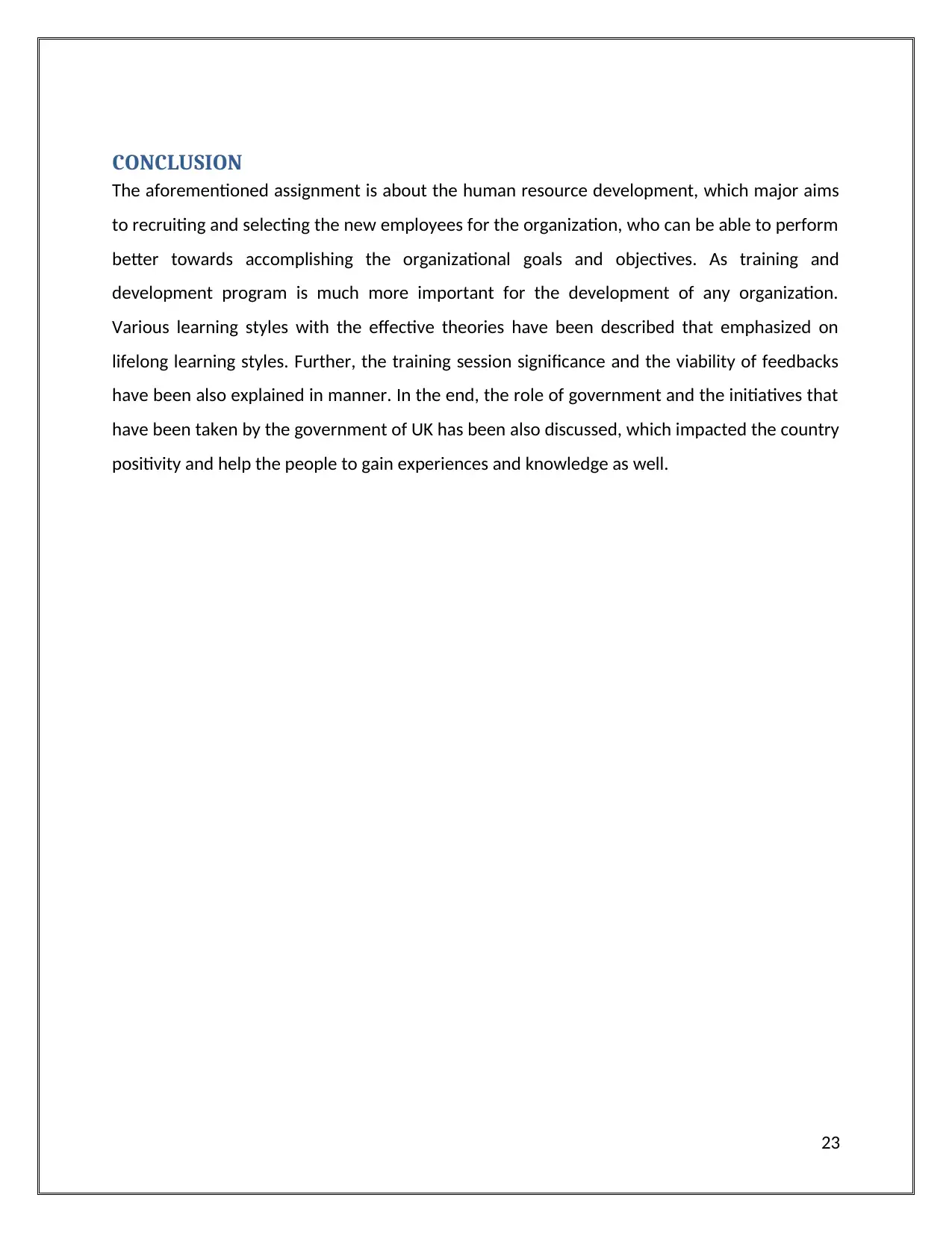
CONCLUSION
The aforementioned assignment is about the human resource development, which major aims
to recruiting and selecting the new employees for the organization, who can be able to perform
better towards accomplishing the organizational goals and objectives. As training and
development program is much more important for the development of any organization.
Various learning styles with the effective theories have been described that emphasized on
lifelong learning styles. Further, the training session significance and the viability of feedbacks
have been also explained in manner. In the end, the role of government and the initiatives that
have been taken by the government of UK has been also discussed, which impacted the country
positivity and help the people to gain experiences and knowledge as well.
23
The aforementioned assignment is about the human resource development, which major aims
to recruiting and selecting the new employees for the organization, who can be able to perform
better towards accomplishing the organizational goals and objectives. As training and
development program is much more important for the development of any organization.
Various learning styles with the effective theories have been described that emphasized on
lifelong learning styles. Further, the training session significance and the viability of feedbacks
have been also explained in manner. In the end, the role of government and the initiatives that
have been taken by the government of UK has been also discussed, which impacted the country
positivity and help the people to gain experiences and knowledge as well.
23
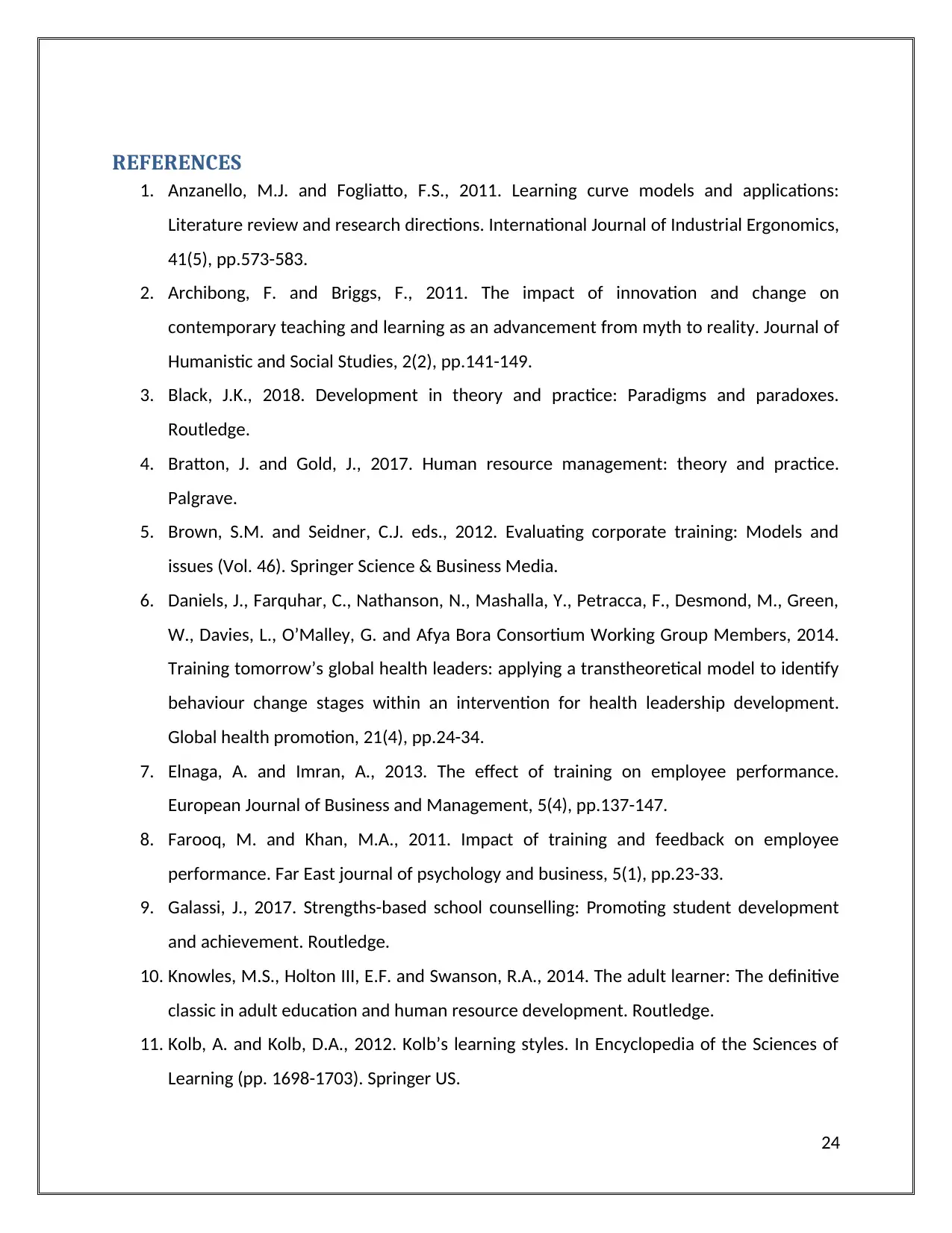
REFERENCES
1. Anzanello, M.J. and Fogliatto, F.S., 2011. Learning curve models and applications:
Literature review and research directions. International Journal of Industrial Ergonomics,
41(5), pp.573-583.
2. Archibong, F. and Briggs, F., 2011. The impact of innovation and change on
contemporary teaching and learning as an advancement from myth to reality. Journal of
Humanistic and Social Studies, 2(2), pp.141-149.
3. Black, J.K., 2018. Development in theory and practice: Paradigms and paradoxes.
Routledge.
4. Bratton, J. and Gold, J., 2017. Human resource management: theory and practice.
Palgrave.
5. Brown, S.M. and Seidner, C.J. eds., 2012. Evaluating corporate training: Models and
issues (Vol. 46). Springer Science & Business Media.
6. Daniels, J., Farquhar, C., Nathanson, N., Mashalla, Y., Petracca, F., Desmond, M., Green,
W., Davies, L., O’Malley, G. and Afya Bora Consortium Working Group Members, 2014.
Training tomorrow’s global health leaders: applying a transtheoretical model to identify
behaviour change stages within an intervention for health leadership development.
Global health promotion, 21(4), pp.24-34.
7. Elnaga, A. and Imran, A., 2013. The effect of training on employee performance.
European Journal of Business and Management, 5(4), pp.137-147.
8. Farooq, M. and Khan, M.A., 2011. Impact of training and feedback on employee
performance. Far East journal of psychology and business, 5(1), pp.23-33.
9. Galassi, J., 2017. Strengths-based school counselling: Promoting student development
and achievement. Routledge.
10. Knowles, M.S., Holton III, E.F. and Swanson, R.A., 2014. The adult learner: The definitive
classic in adult education and human resource development. Routledge.
11. Kolb, A. and Kolb, D.A., 2012. Kolb’s learning styles. In Encyclopedia of the Sciences of
Learning (pp. 1698-1703). Springer US.
24
1. Anzanello, M.J. and Fogliatto, F.S., 2011. Learning curve models and applications:
Literature review and research directions. International Journal of Industrial Ergonomics,
41(5), pp.573-583.
2. Archibong, F. and Briggs, F., 2011. The impact of innovation and change on
contemporary teaching and learning as an advancement from myth to reality. Journal of
Humanistic and Social Studies, 2(2), pp.141-149.
3. Black, J.K., 2018. Development in theory and practice: Paradigms and paradoxes.
Routledge.
4. Bratton, J. and Gold, J., 2017. Human resource management: theory and practice.
Palgrave.
5. Brown, S.M. and Seidner, C.J. eds., 2012. Evaluating corporate training: Models and
issues (Vol. 46). Springer Science & Business Media.
6. Daniels, J., Farquhar, C., Nathanson, N., Mashalla, Y., Petracca, F., Desmond, M., Green,
W., Davies, L., O’Malley, G. and Afya Bora Consortium Working Group Members, 2014.
Training tomorrow’s global health leaders: applying a transtheoretical model to identify
behaviour change stages within an intervention for health leadership development.
Global health promotion, 21(4), pp.24-34.
7. Elnaga, A. and Imran, A., 2013. The effect of training on employee performance.
European Journal of Business and Management, 5(4), pp.137-147.
8. Farooq, M. and Khan, M.A., 2011. Impact of training and feedback on employee
performance. Far East journal of psychology and business, 5(1), pp.23-33.
9. Galassi, J., 2017. Strengths-based school counselling: Promoting student development
and achievement. Routledge.
10. Knowles, M.S., Holton III, E.F. and Swanson, R.A., 2014. The adult learner: The definitive
classic in adult education and human resource development. Routledge.
11. Kolb, A. and Kolb, D.A., 2012. Kolb’s learning styles. In Encyclopedia of the Sciences of
Learning (pp. 1698-1703). Springer US.
24
Paraphrase This Document
Need a fresh take? Get an instant paraphrase of this document with our AI Paraphraser
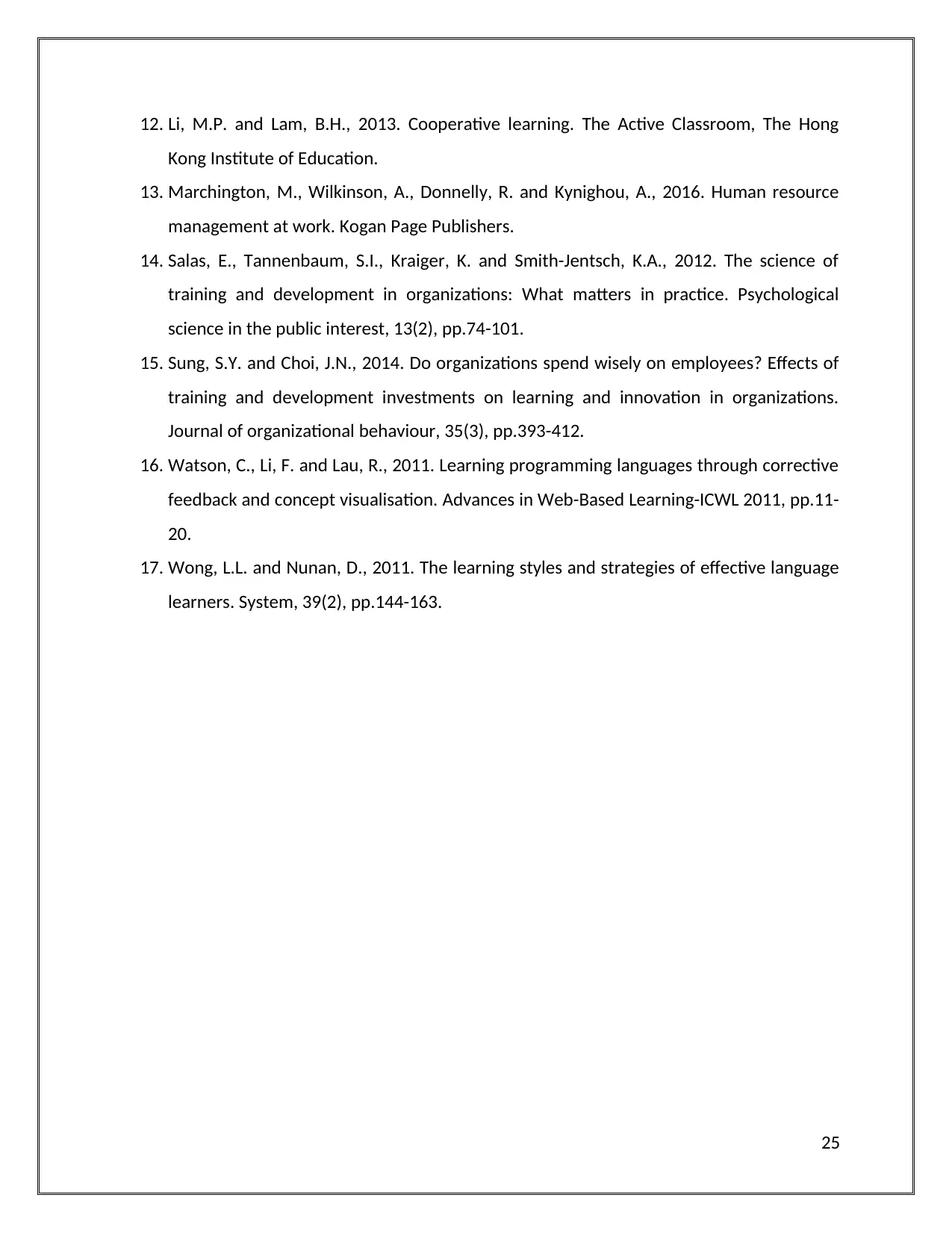
12. Li, M.P. and Lam, B.H., 2013. Cooperative learning. The Active Classroom, The Hong
Kong Institute of Education.
13. Marchington, M., Wilkinson, A., Donnelly, R. and Kynighou, A., 2016. Human resource
management at work. Kogan Page Publishers.
14. Salas, E., Tannenbaum, S.I., Kraiger, K. and Smith-Jentsch, K.A., 2012. The science of
training and development in organizations: What matters in practice. Psychological
science in the public interest, 13(2), pp.74-101.
15. Sung, S.Y. and Choi, J.N., 2014. Do organizations spend wisely on employees? Effects of
training and development investments on learning and innovation in organizations.
Journal of organizational behaviour, 35(3), pp.393-412.
16. Watson, C., Li, F. and Lau, R., 2011. Learning programming languages through corrective
feedback and concept visualisation. Advances in Web-Based Learning-ICWL 2011, pp.11-
20.
17. Wong, L.L. and Nunan, D., 2011. The learning styles and strategies of effective language
learners. System, 39(2), pp.144-163.
25
Kong Institute of Education.
13. Marchington, M., Wilkinson, A., Donnelly, R. and Kynighou, A., 2016. Human resource
management at work. Kogan Page Publishers.
14. Salas, E., Tannenbaum, S.I., Kraiger, K. and Smith-Jentsch, K.A., 2012. The science of
training and development in organizations: What matters in practice. Psychological
science in the public interest, 13(2), pp.74-101.
15. Sung, S.Y. and Choi, J.N., 2014. Do organizations spend wisely on employees? Effects of
training and development investments on learning and innovation in organizations.
Journal of organizational behaviour, 35(3), pp.393-412.
16. Watson, C., Li, F. and Lau, R., 2011. Learning programming languages through corrective
feedback and concept visualisation. Advances in Web-Based Learning-ICWL 2011, pp.11-
20.
17. Wong, L.L. and Nunan, D., 2011. The learning styles and strategies of effective language
learners. System, 39(2), pp.144-163.
25

26
1 out of 27
Related Documents
Your All-in-One AI-Powered Toolkit for Academic Success.
+13062052269
info@desklib.com
Available 24*7 on WhatsApp / Email
![[object Object]](/_next/static/media/star-bottom.7253800d.svg)
Unlock your academic potential
© 2024 | Zucol Services PVT LTD | All rights reserved.





